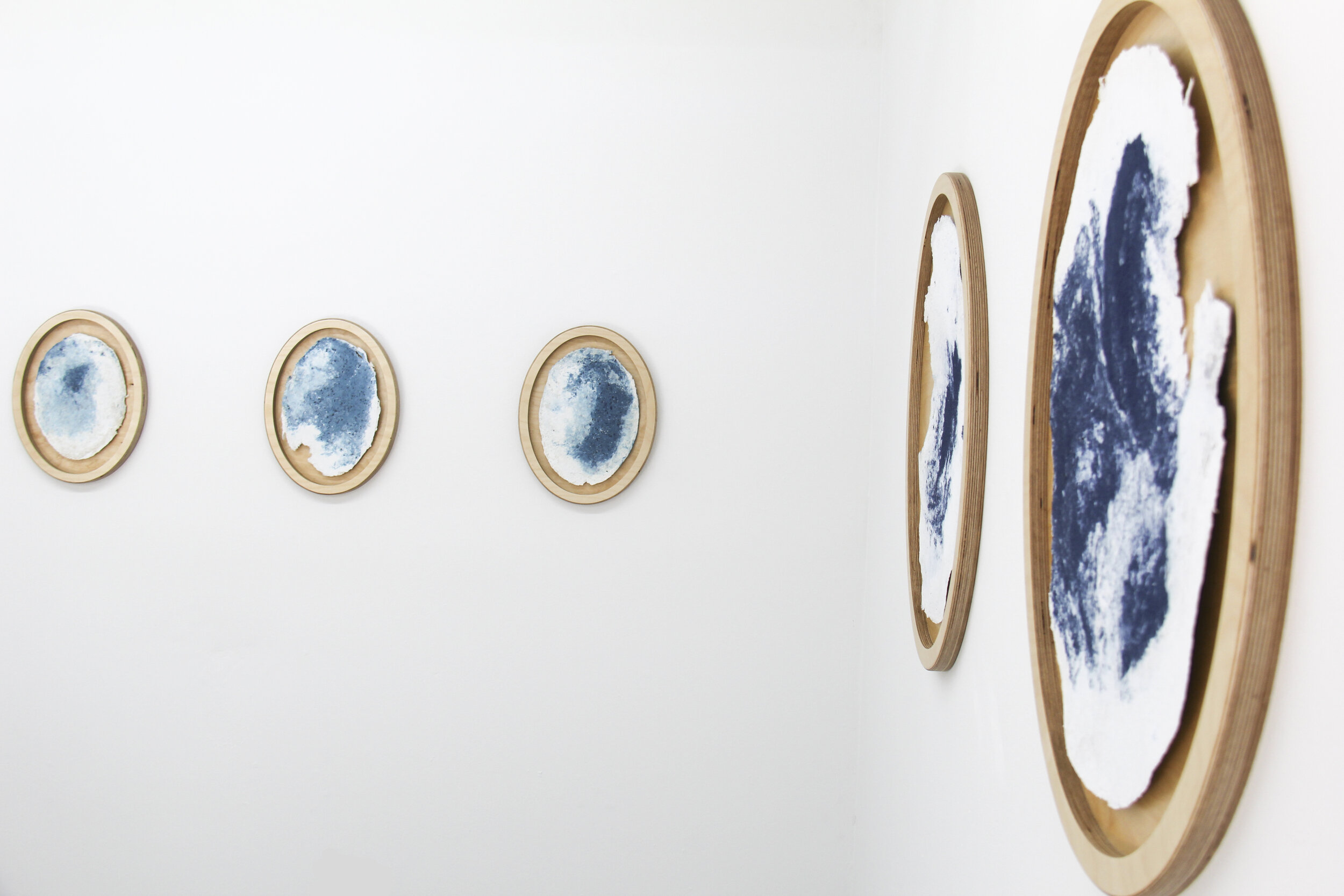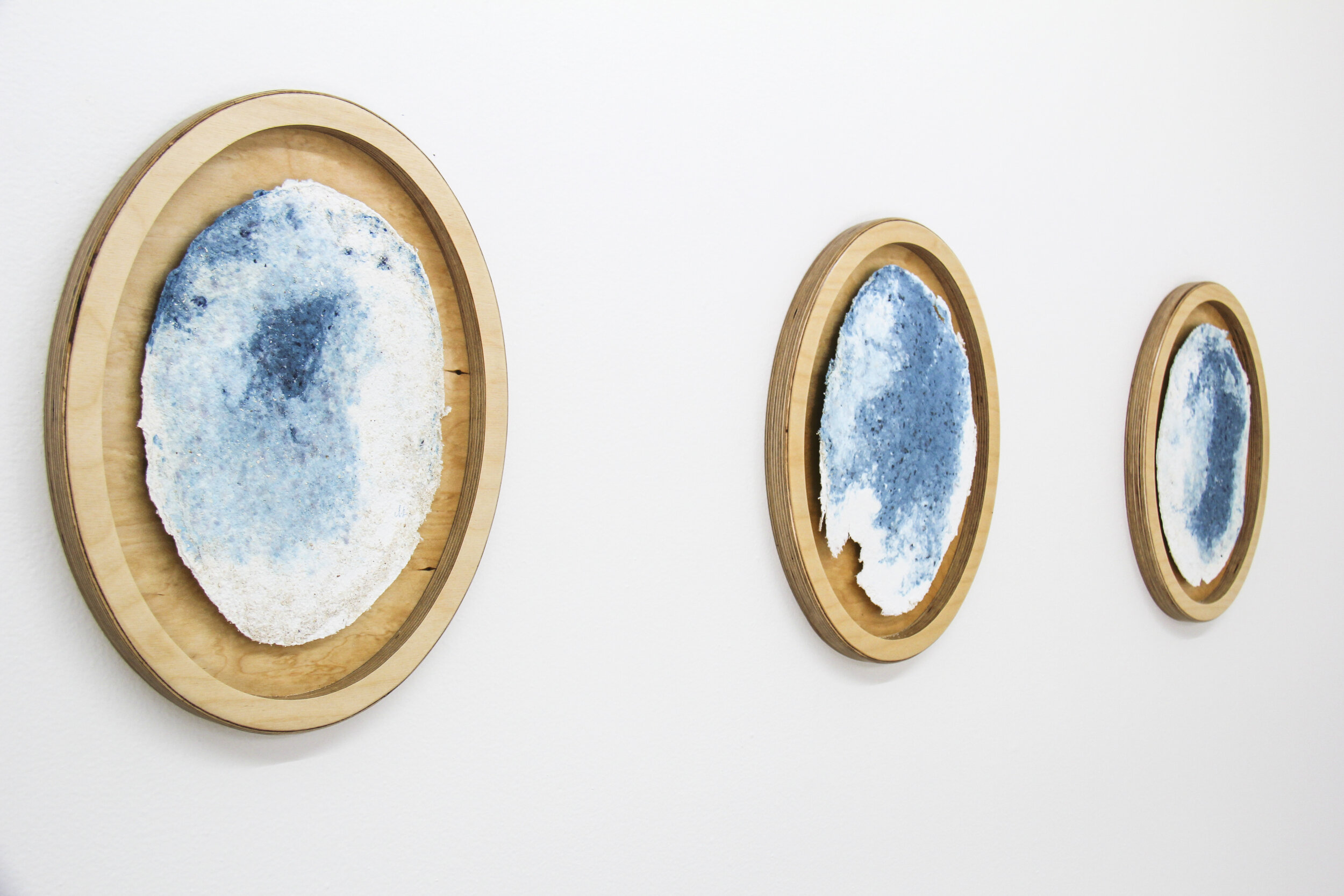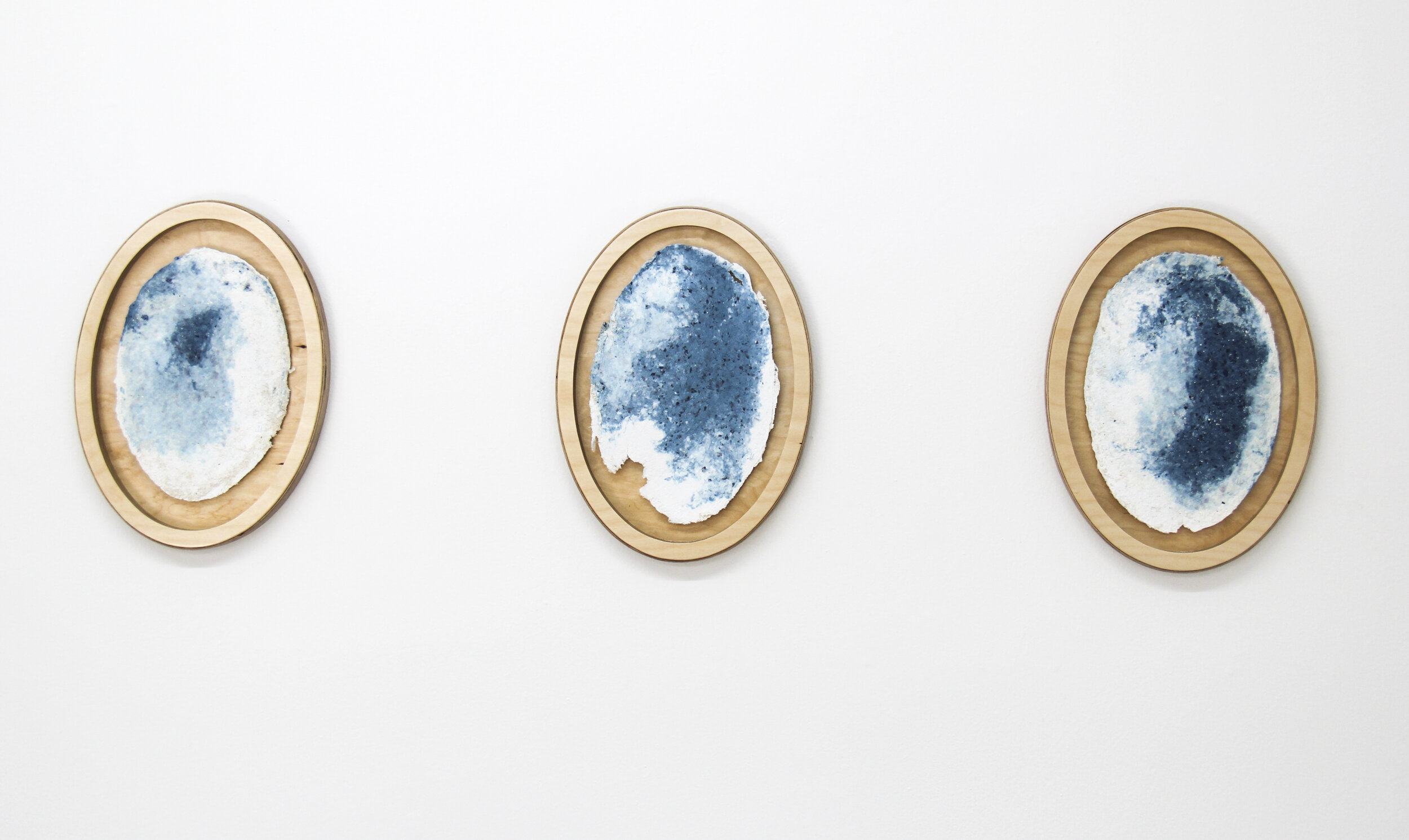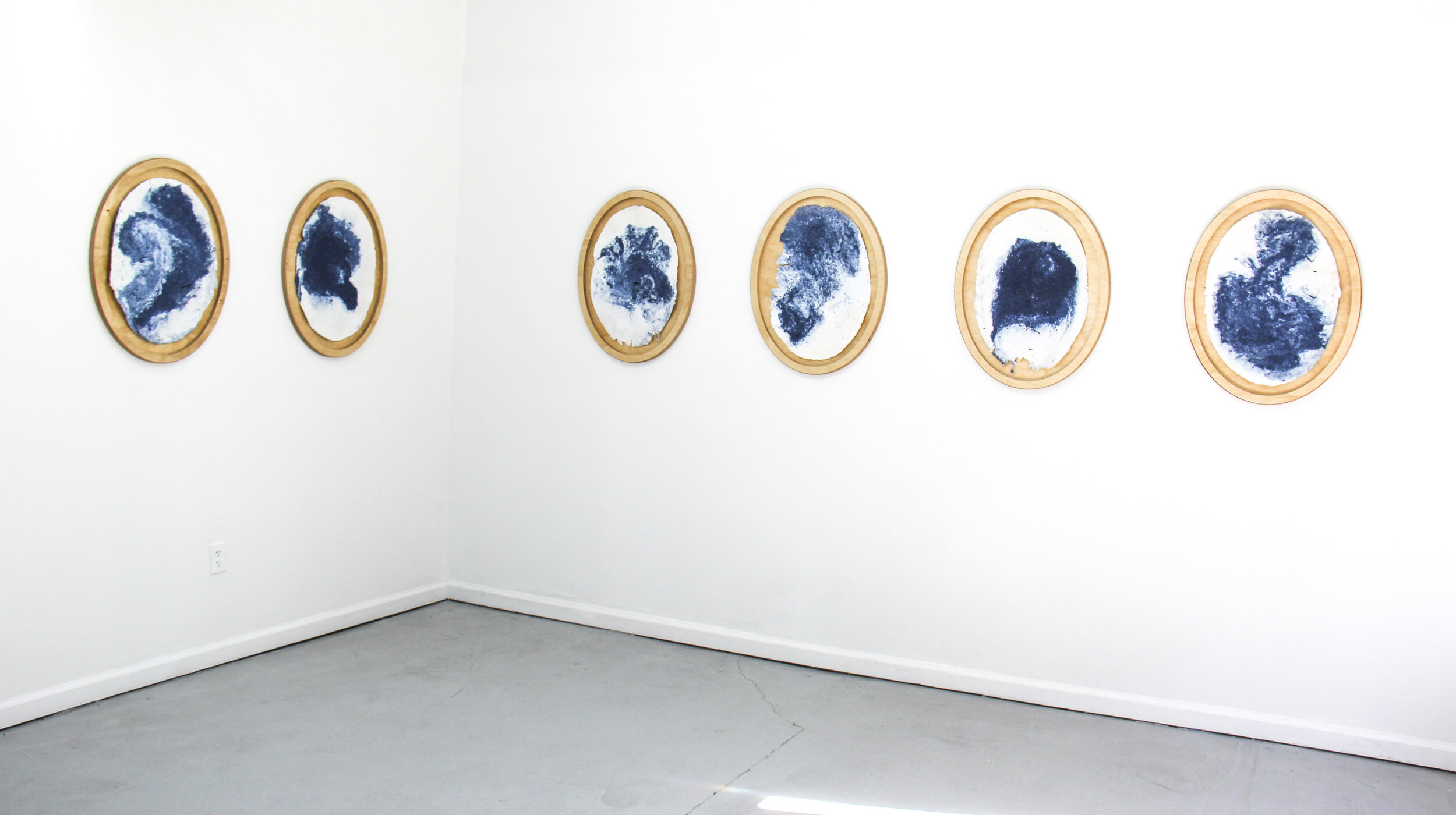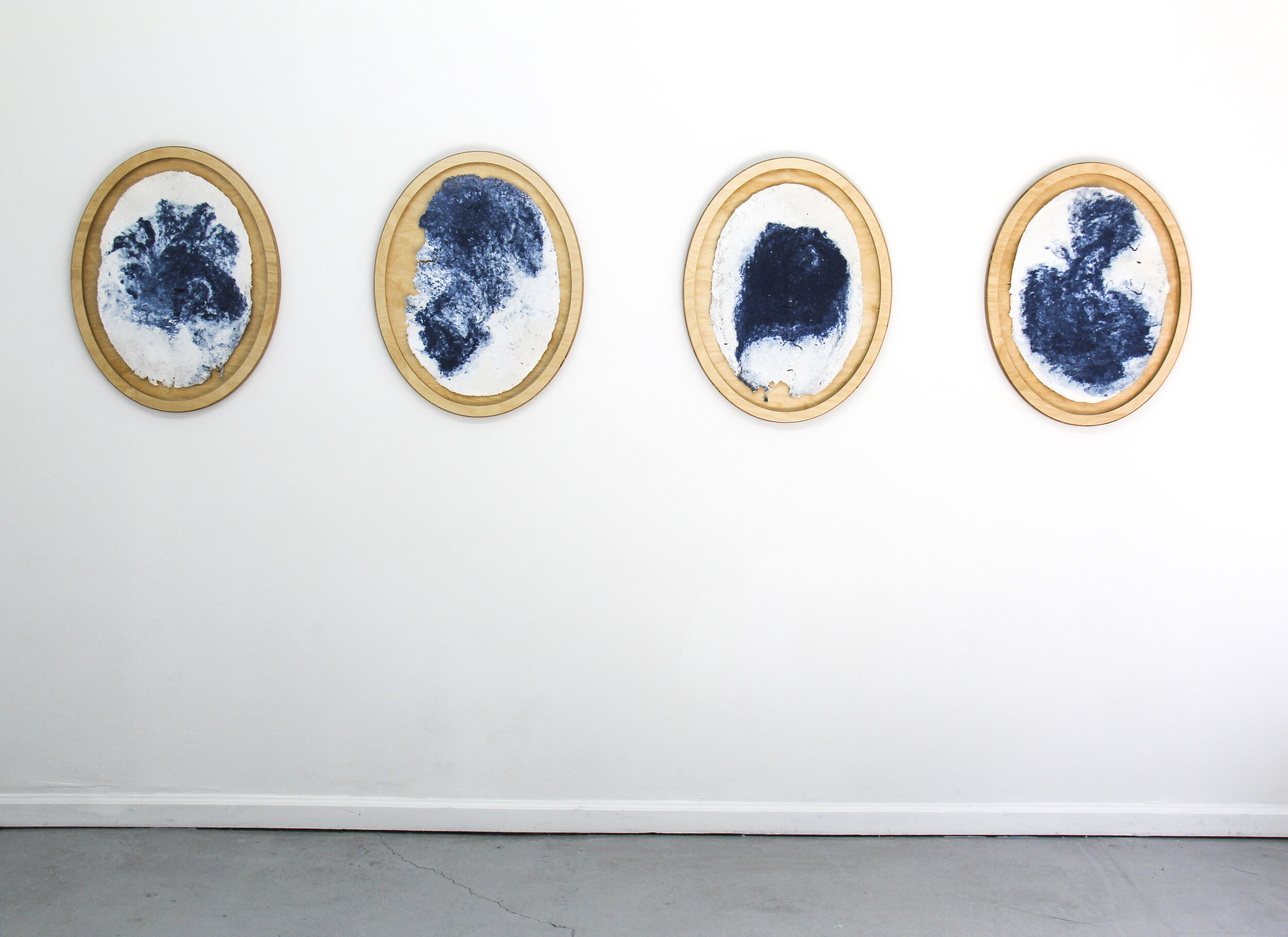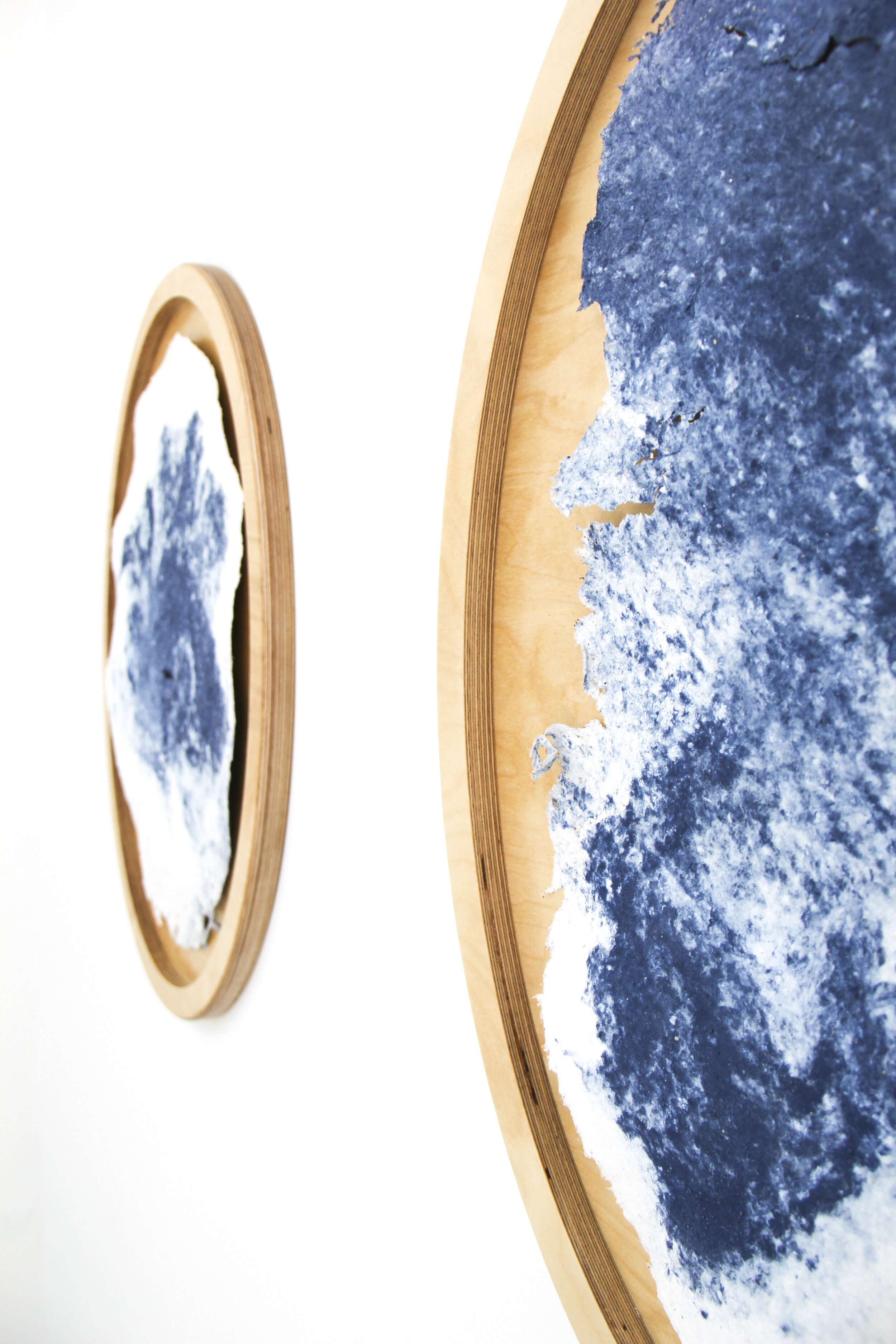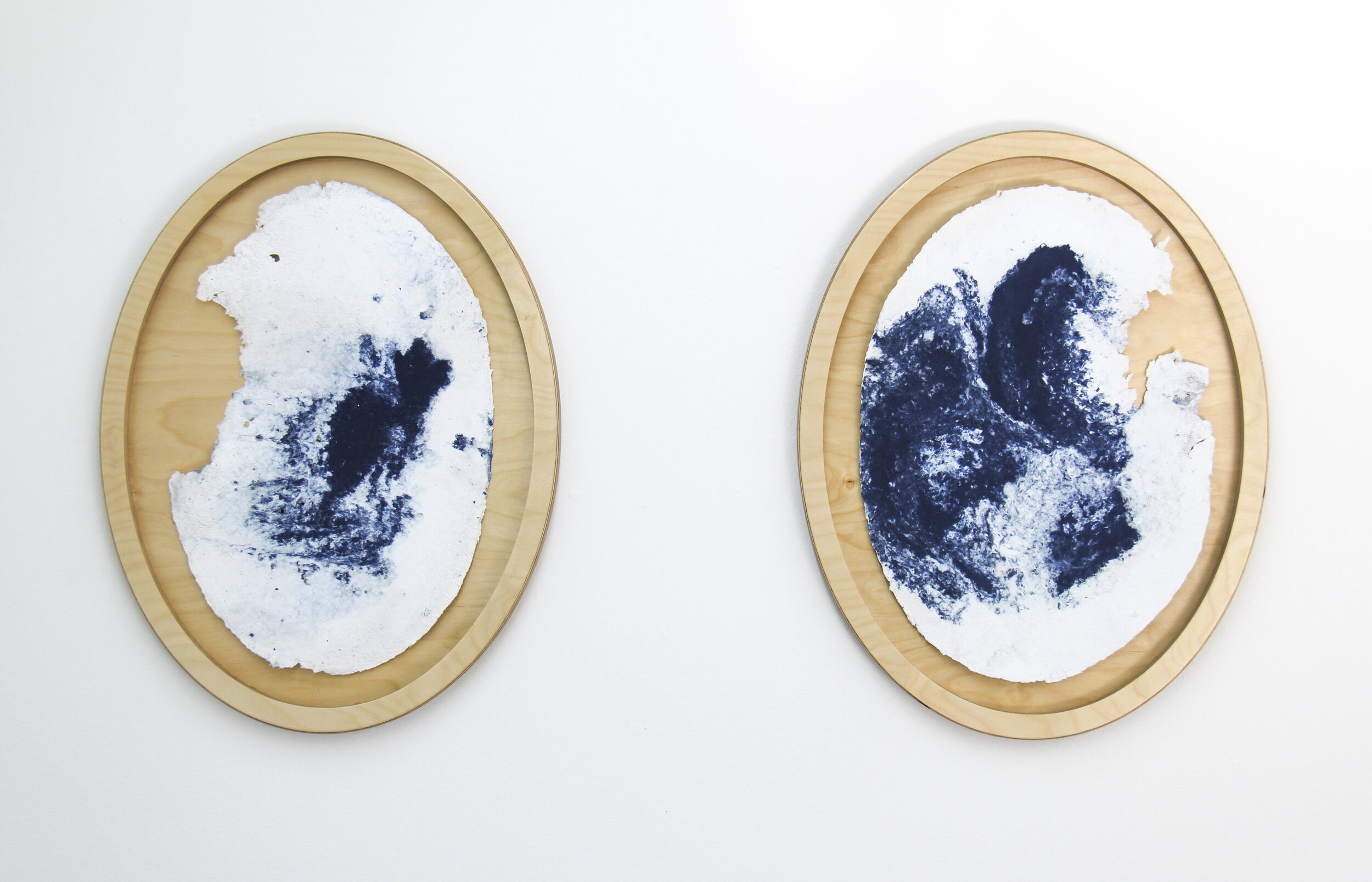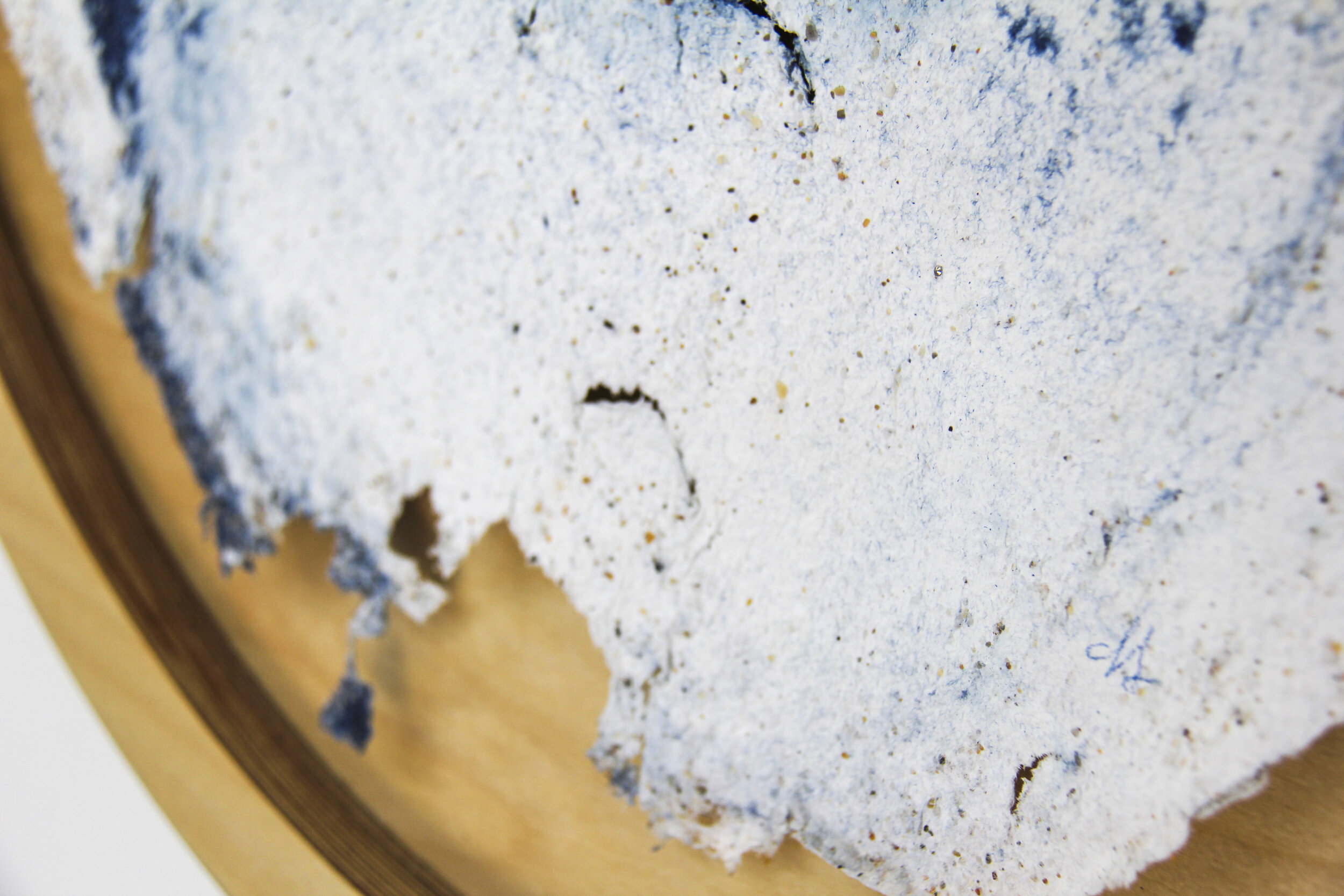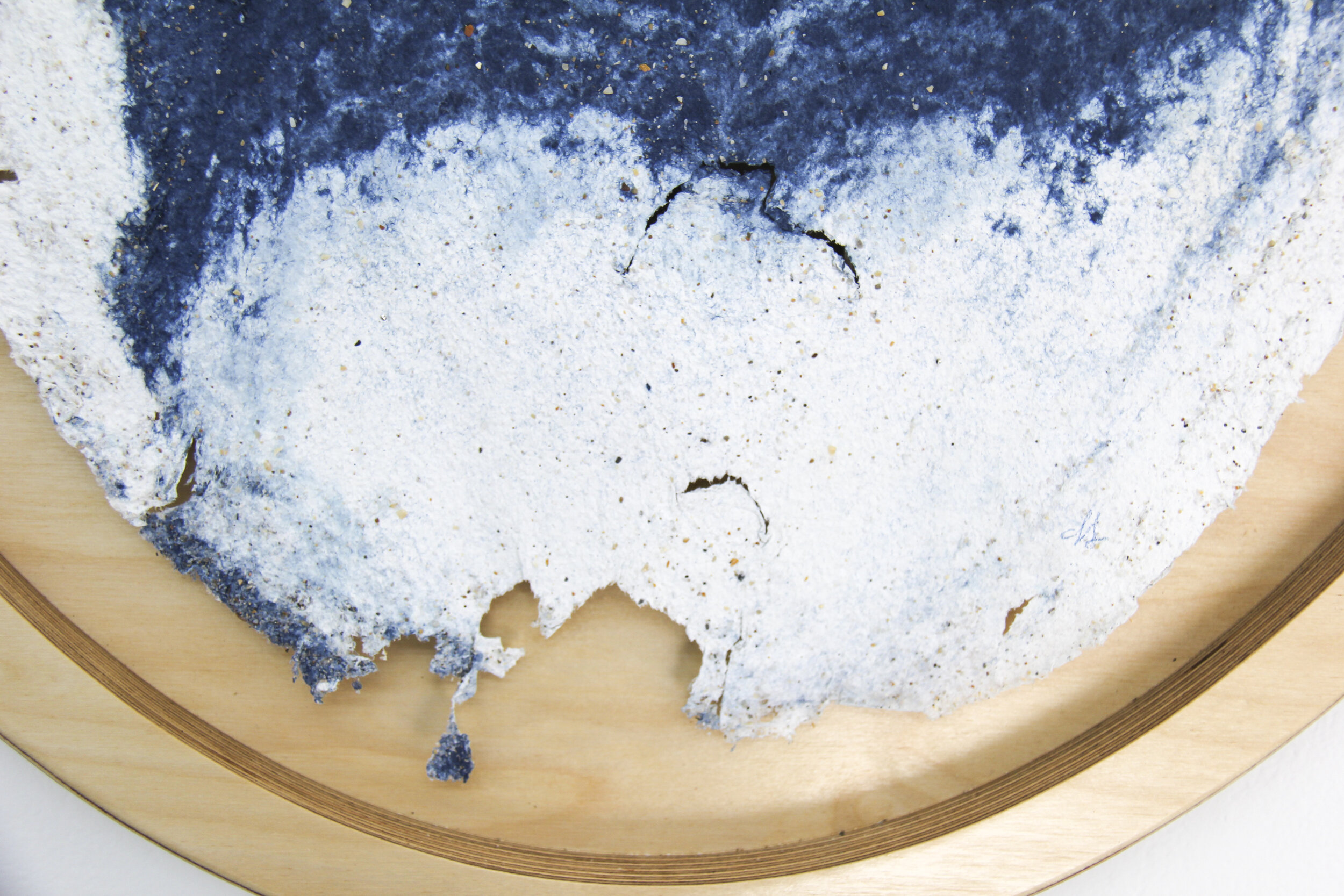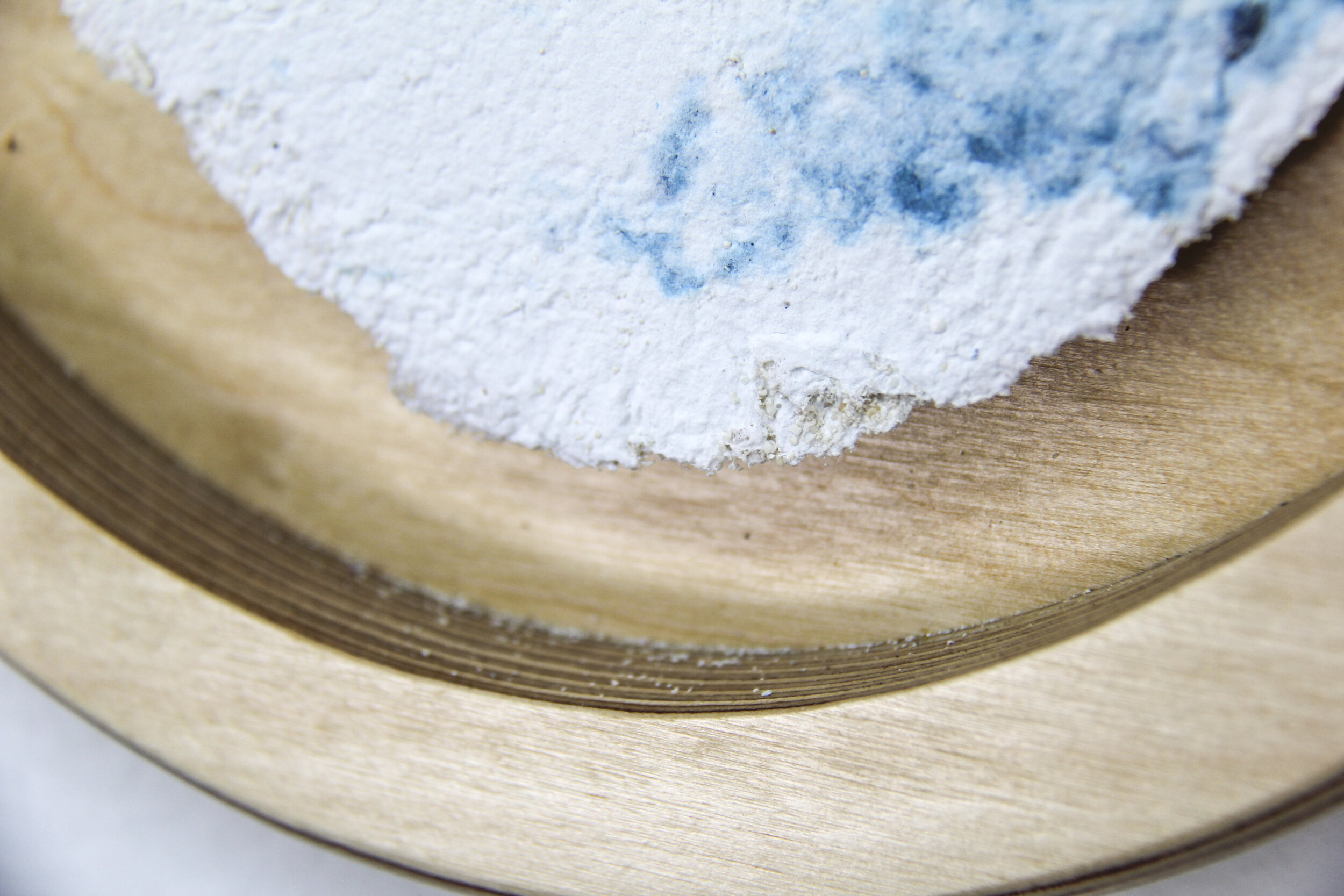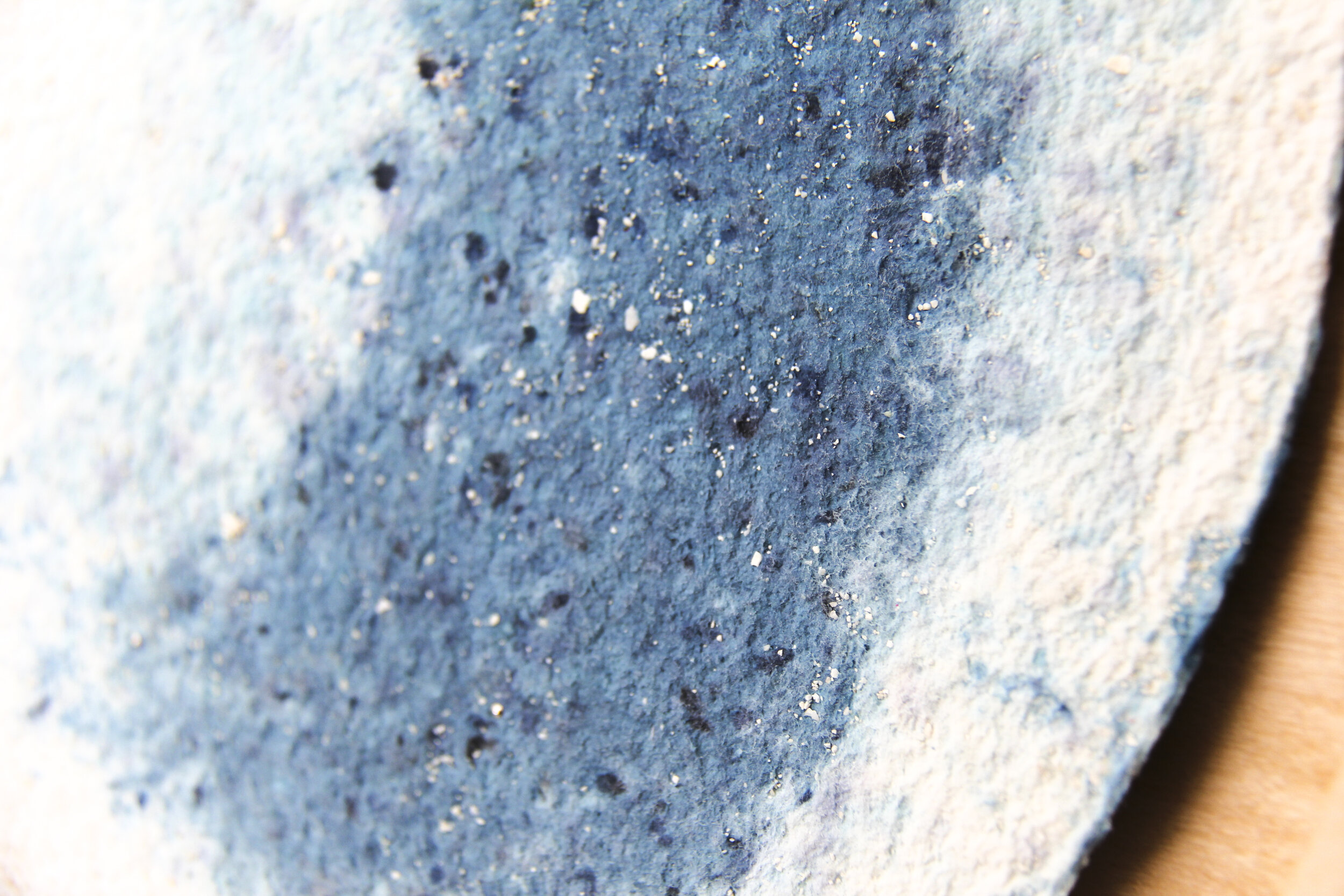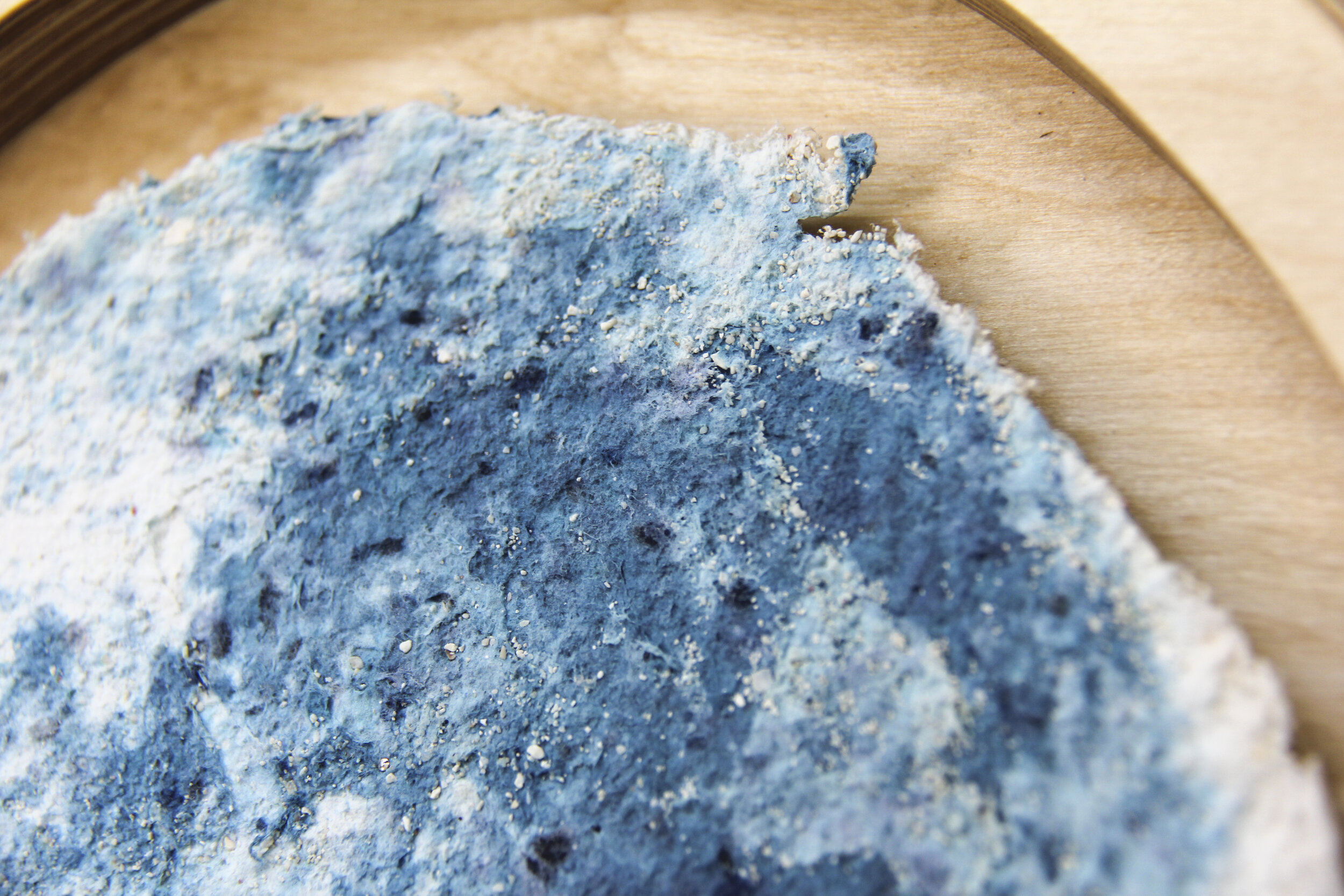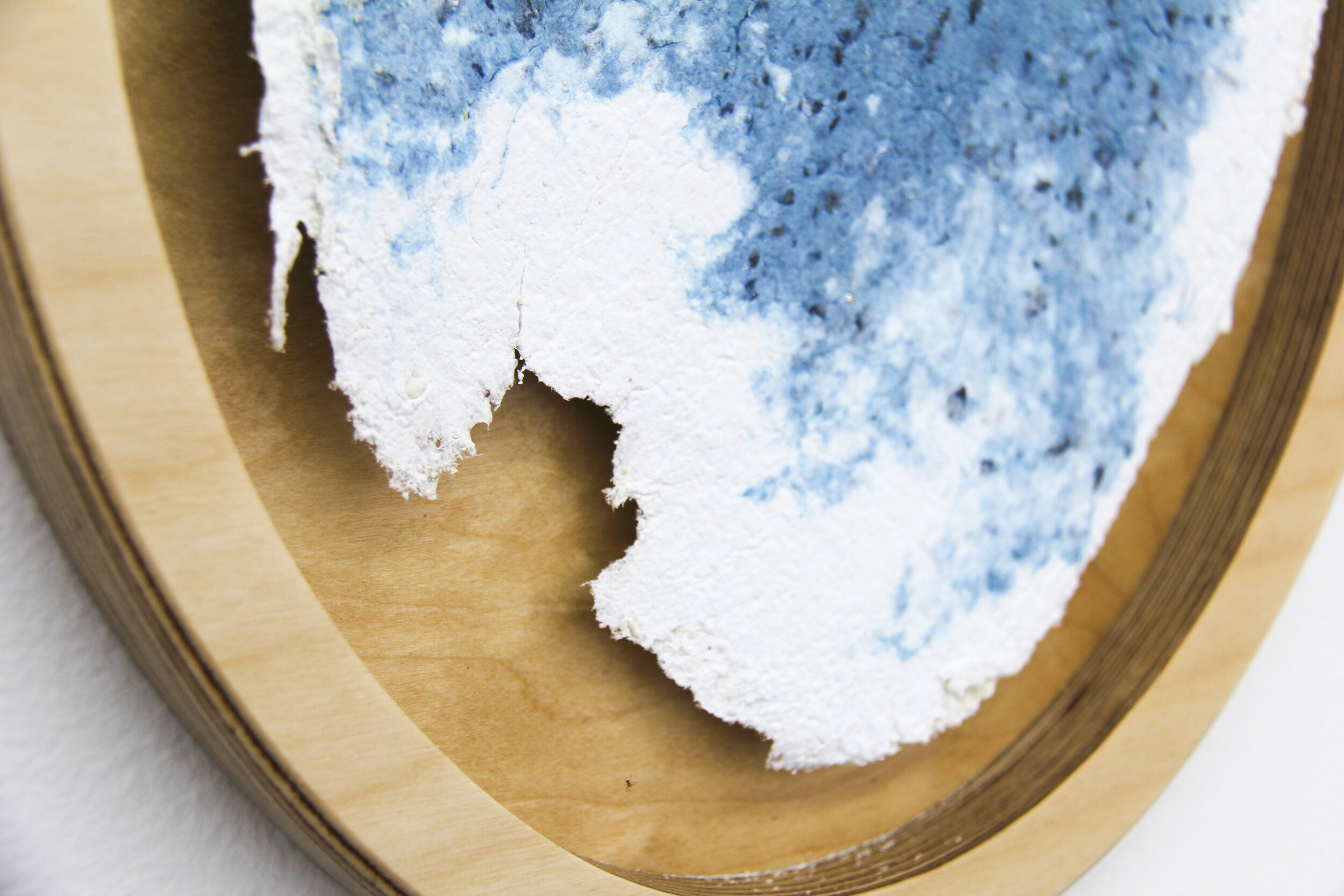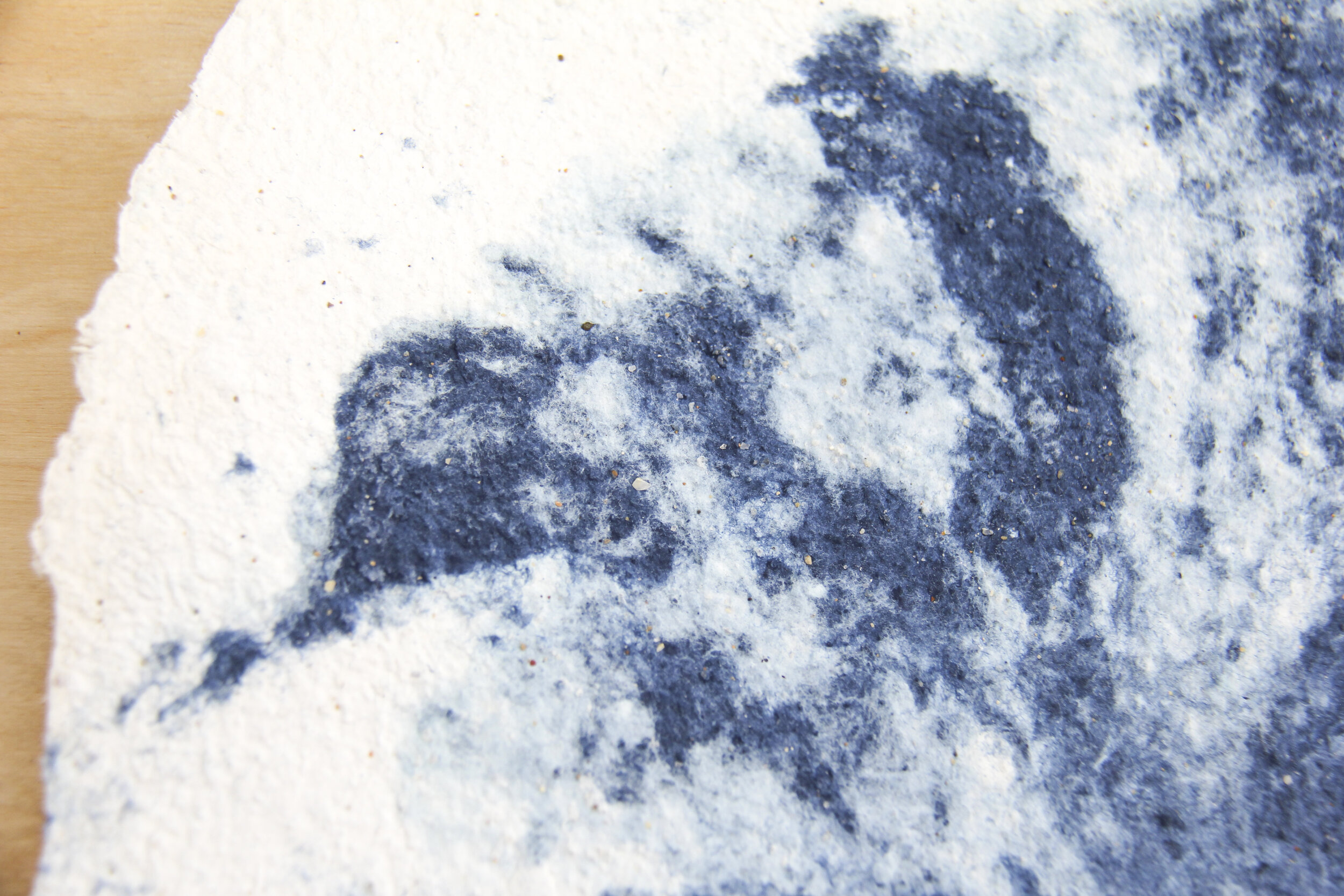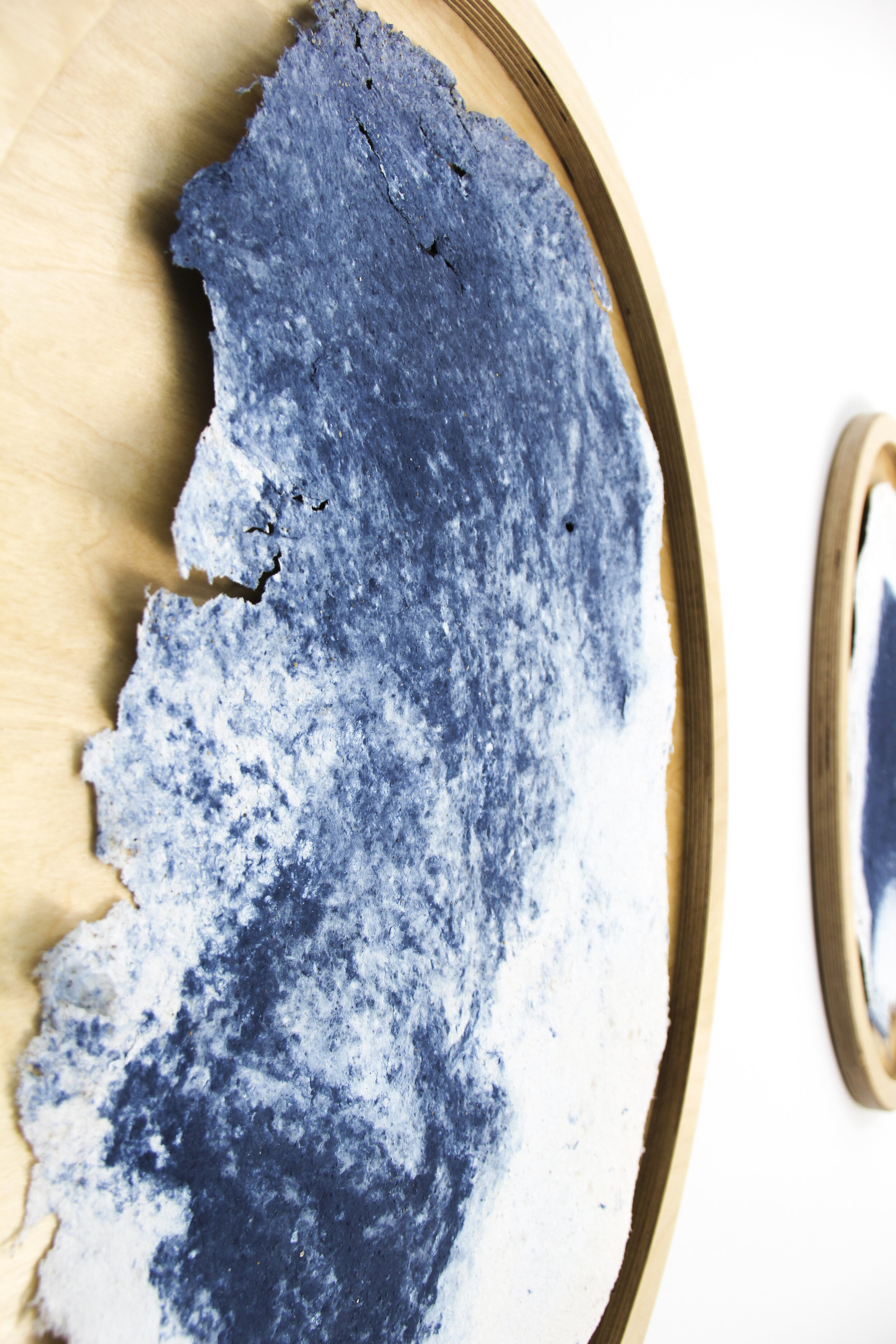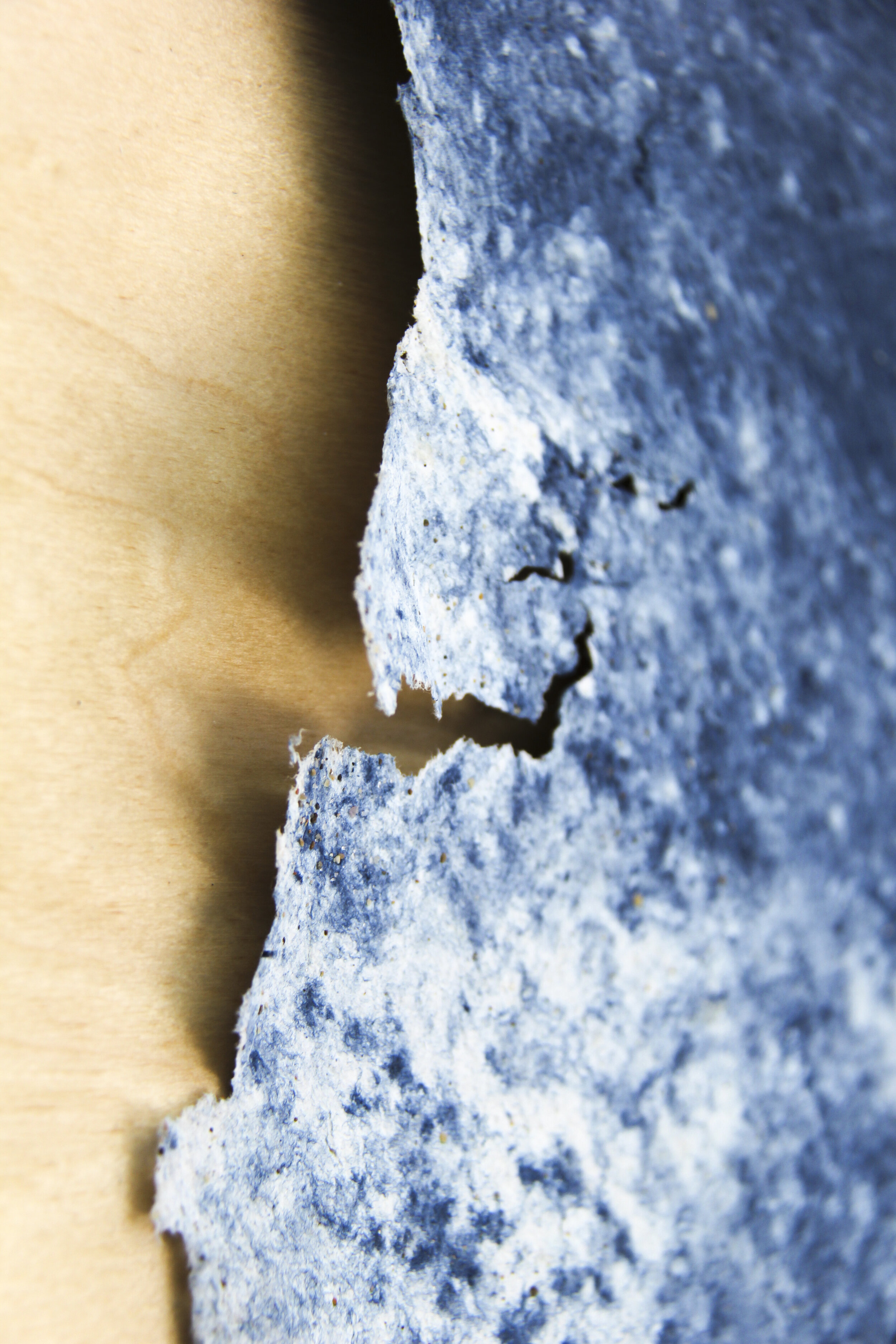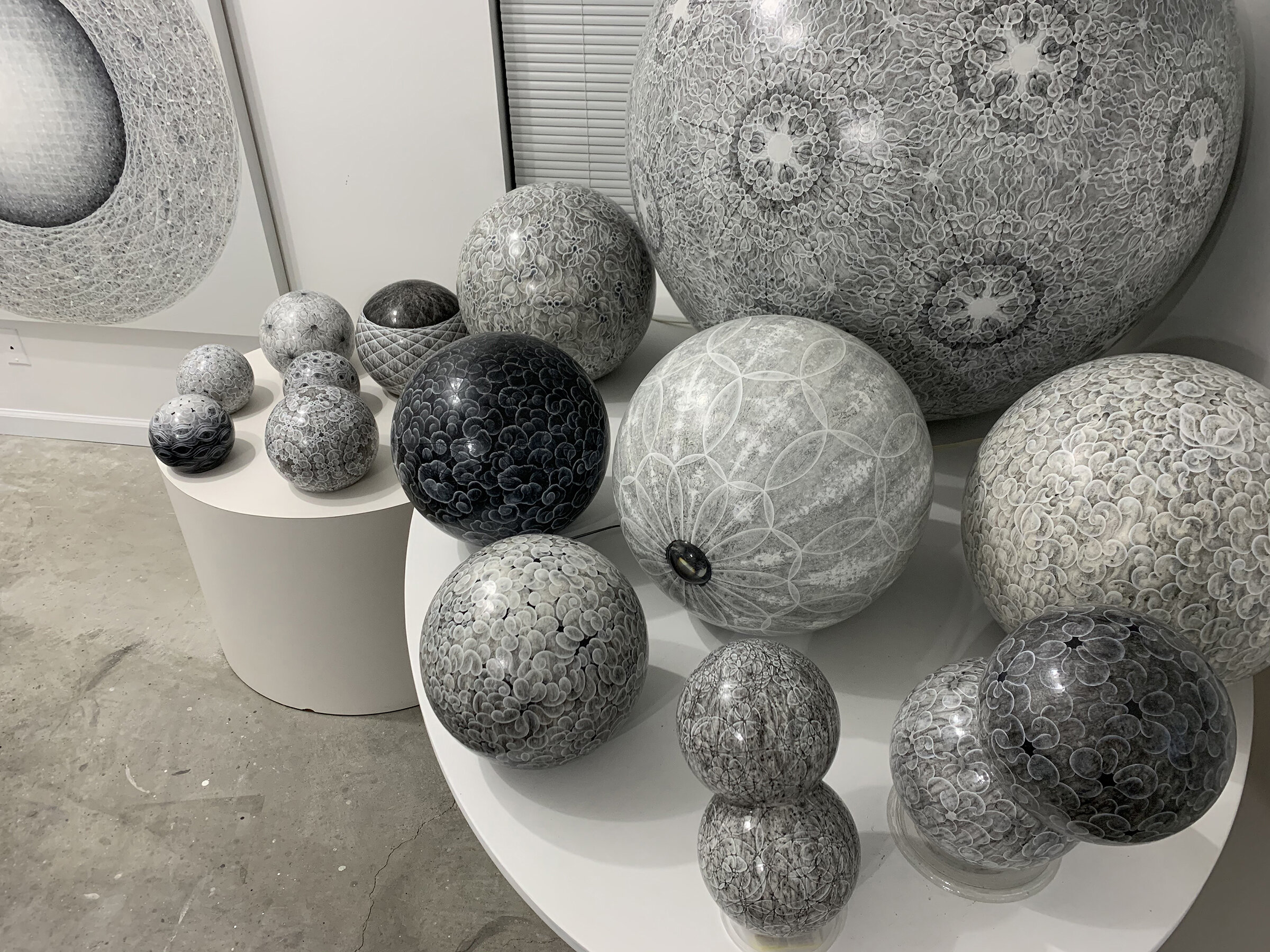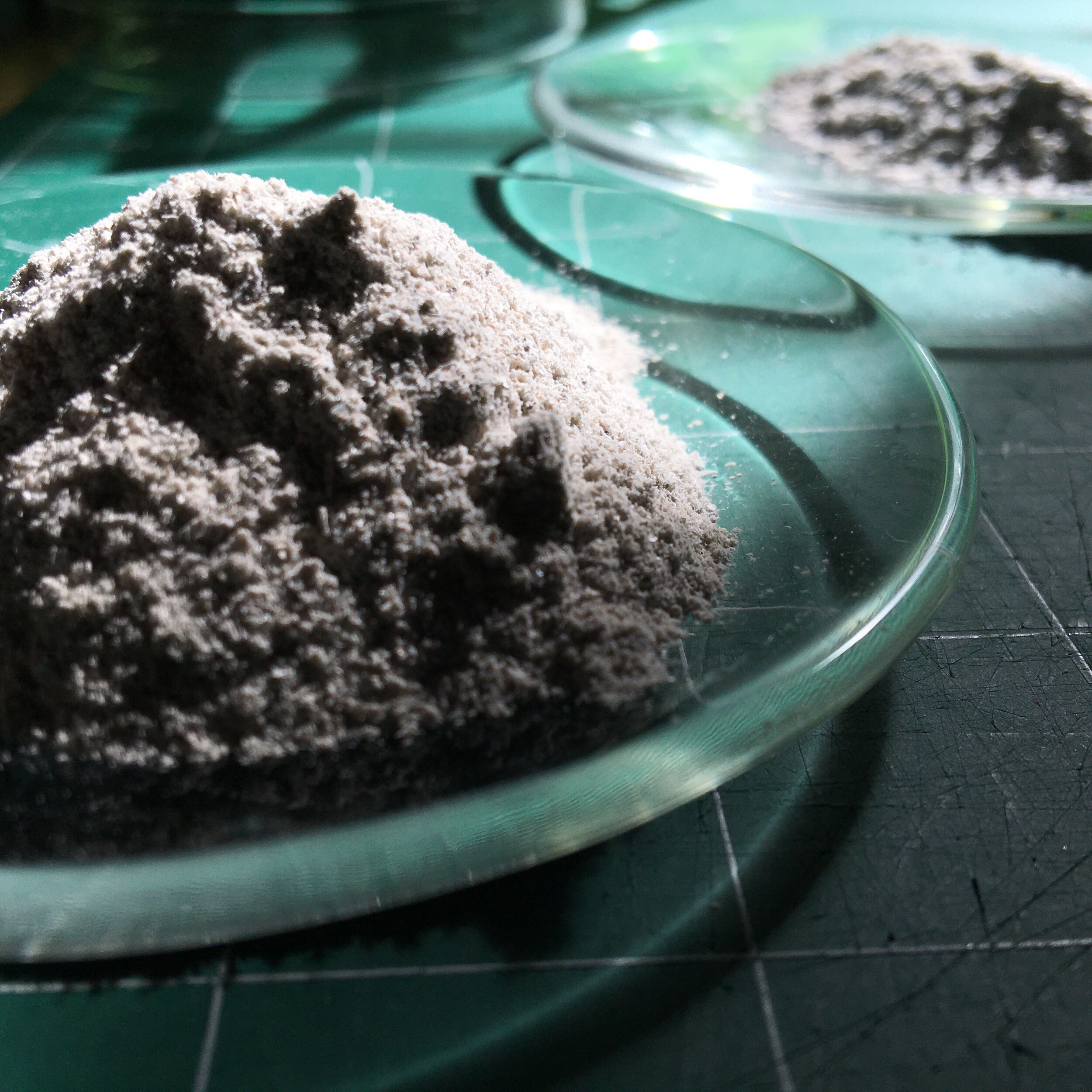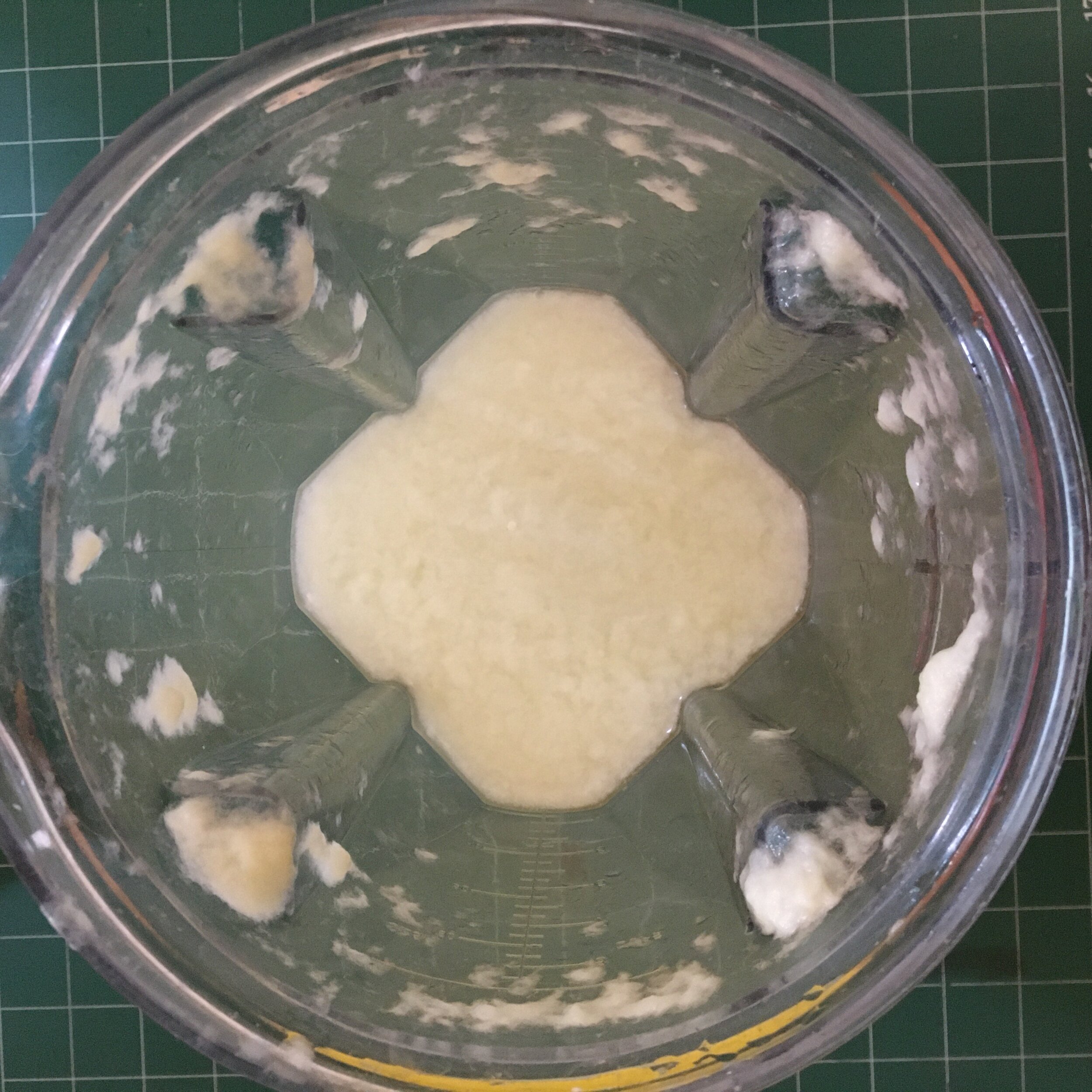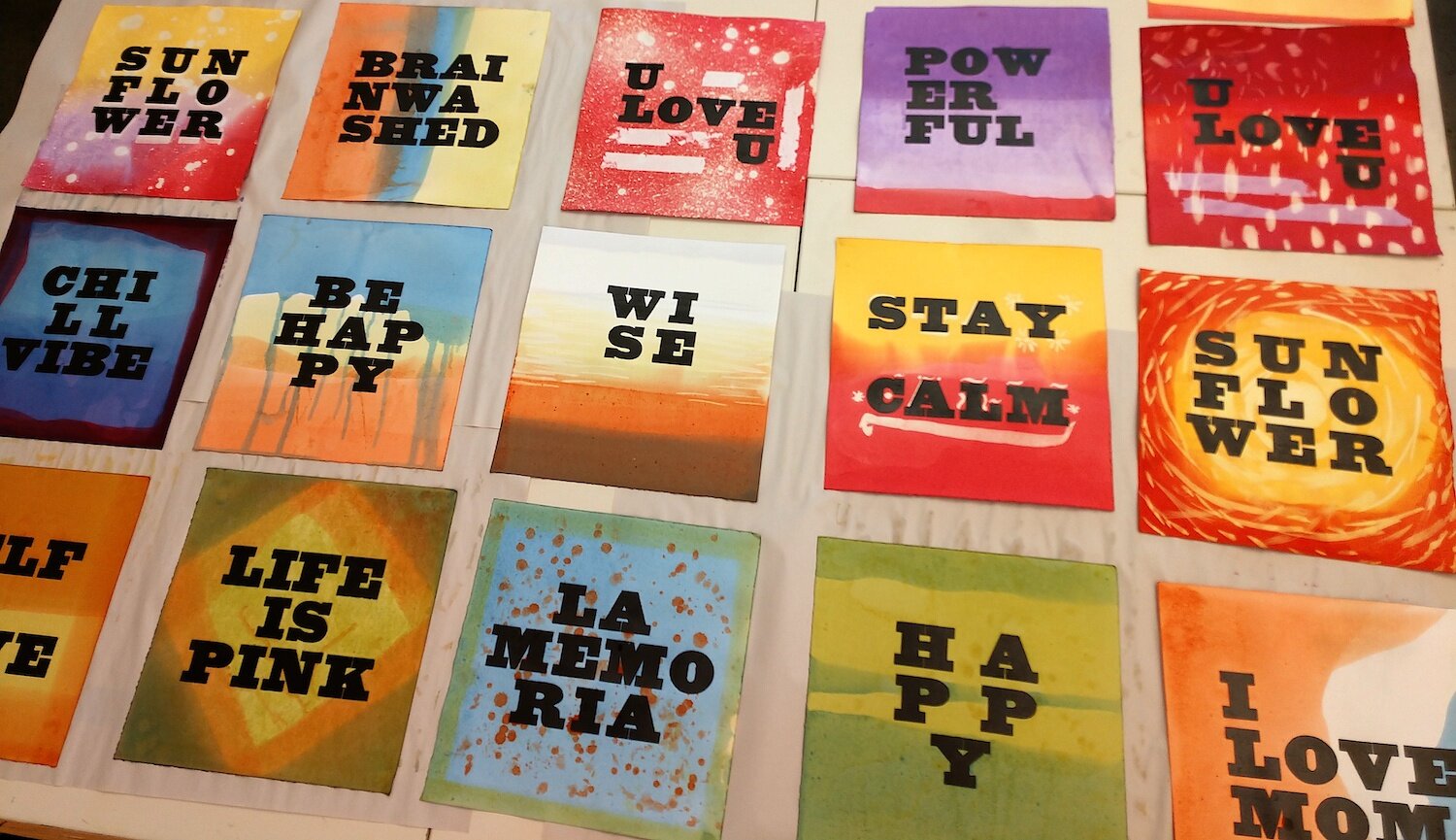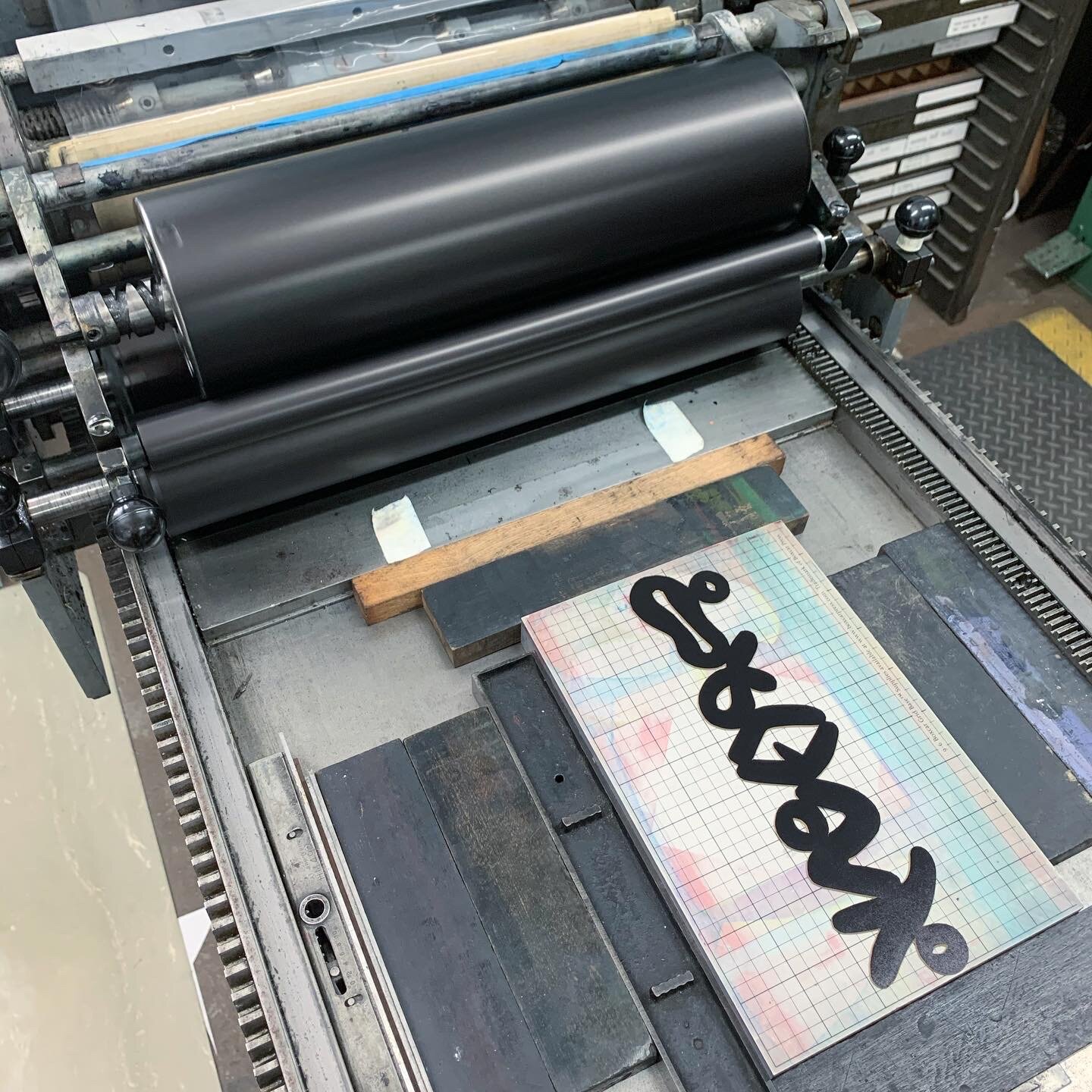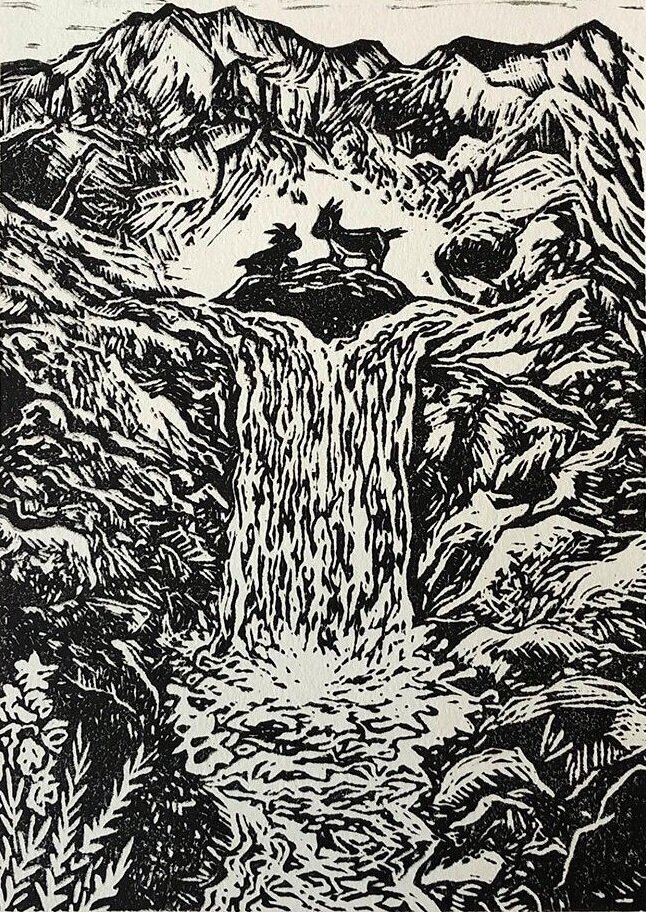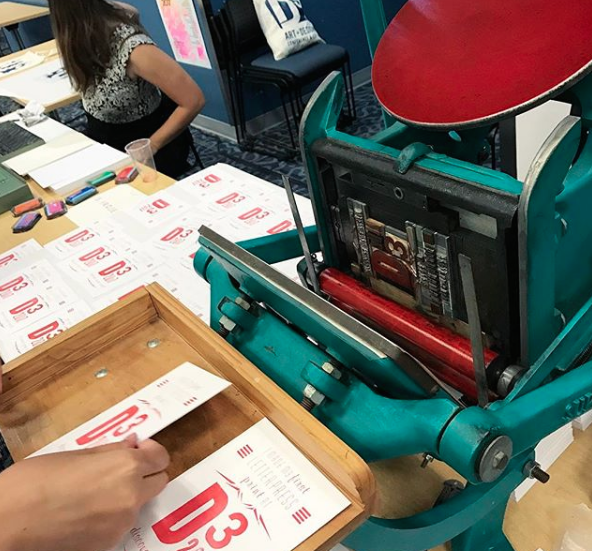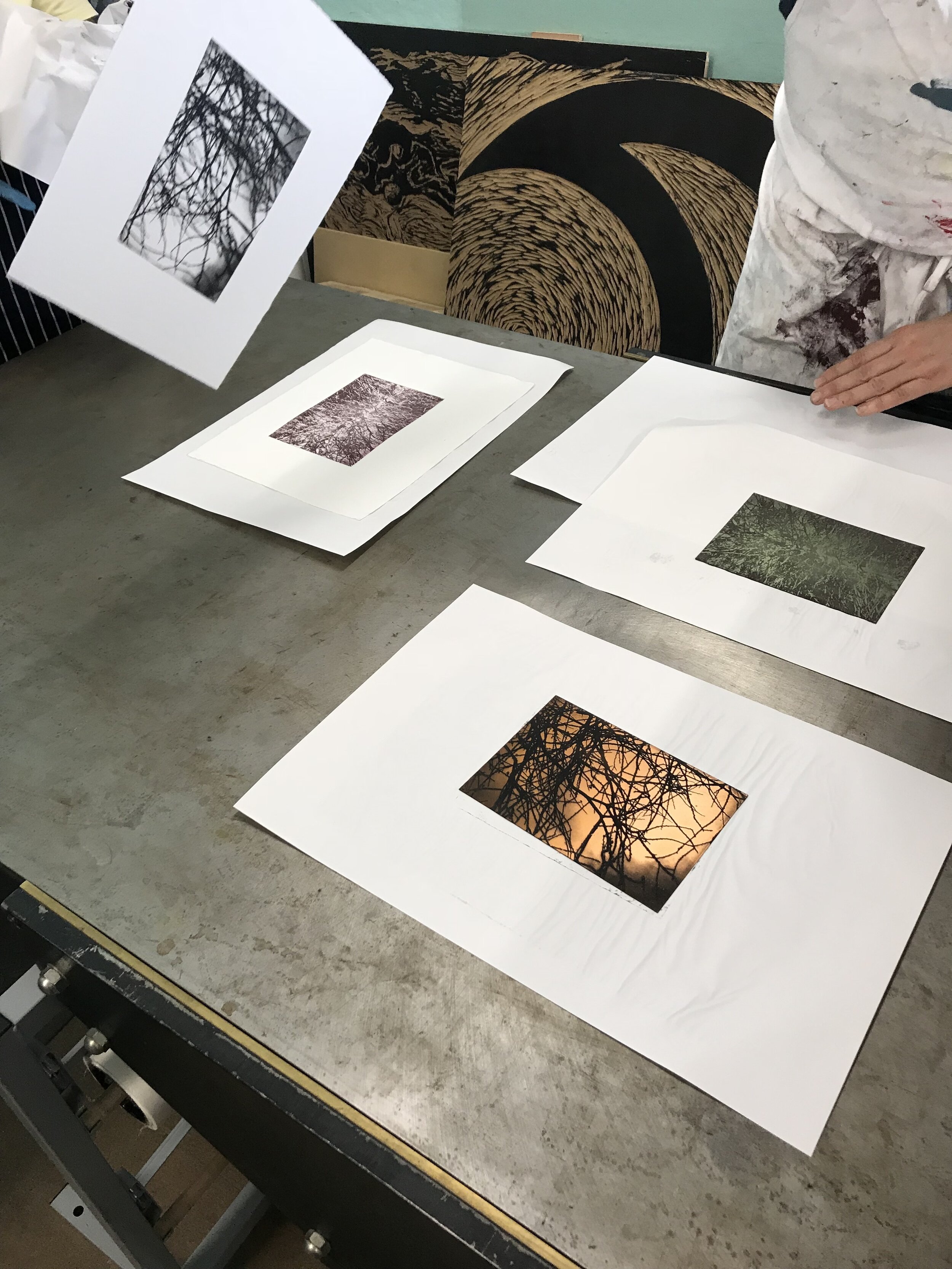A Closer Look: Water Draws Itself by Ingrid Schindall
If you are familiar with IS Projects, then it’s likely you already know its founder and owner, Ingrid Schindall. Owning a print shop has heavily influenced her personal practice by focusing on both community-driven and personal projects over the last six years. It is through this ‘Closer Look’ that we more intently investigate one of Ingrid’s personal papermaking projects through her solo exhibition, Water Draws Itself.
Water Draws Itself uses the process of papermaking to document the artist’s surroundings through a series of paper pieces made on the beaches of Fort Lauderdale, Naples, and Dry Tortugas, Florida.
If you are familiar with IS Projects, then it’s likely you already know its founder and owner, Ingrid Schindall. Ingrid started IS Projects, the public-access printmaking studio and attached fine art gallery in 2014 with a mission to cultivate a love and appreciation for print and book media in South Florida. Owning a print shop has heavily influenced her personal practice by focusing on both community-driven and personal projects over the last six years. In addition to fine art printmaking, she is devoted to her writing practice and has produced six limited edition books which were all written, designed, hand-printed, and bound herself. It is through this ‘Closer Look’ that we more intently investigate one of Ingrid’s personal papermaking projects through her solo exhibition, Water Draws Itself, on view —both virtually and in-person— in the IS Projects Gallery through early January 2021.
Water Draws Itself uses the process of papermaking to document the artist’s surroundings through a series of paper pieces made on the beaches of Fort Lauderdale, Naples, and Dry Tortugas, Florida. Within the gallery sits a line of the resulting twelve works in varying sizes and shades of blue and white pulp, mounted on oval wood frames. The paper itself is not enclosed behind glass but instead presented in its raw state, allowing the viewer to best witness the delicacy of the work and nuanced textures throughout.
At a glance, the twelve pieces are deceptively similar. It is through closer investigation and time spent in the space that a deeper relationship with each piece is felt — a slight irregularity along one edge or the build-up of sand along the bottom of a frame or the subtle composition shifts of the swirled pulp. It becomes clear that the pieces are not an edition in the traditional sense, but a series of portraits, unique to one another. Ingrid shares, “The pulp used in this project was the same for all of the pieces. The first pieces to be made, Naples 1 and 2, have the darkest blue as the pulp was fresh. When I made the Fort Lauderdale pieces a couple of weeks later, the blue had softened to a slightly lighter green tinted navy. The lighter aqua color is the result of the sustained chemical reaction between the navy blue pigment and the aging pulp. There is the most variety of color in the Dry Tortugas pieces because they were made last and the pulp had gone through a pretty significant transformation.”
NAPLES
FORT LAUDERDALE
DRY TOrtugas
This work emerged as Ingrid began to explore moving her art practice outdoors through papermaking on the beach. As printmakers, we are often tied to the presses or equipment required to produce an edition, so there is a certain freedom that comes with changing up our workspace. However, through this project, Ingrid was specifically interested in encouraging her environment as a collaborator, “in the search to find ways to let water draw itself”.
In Ingrid’s artist talk during the opening reception of this show, she began with a quote from Carl Safina’s book, Song for the Blue Ocean. She states that the following quote has driven her practice and her investigation of water for the past seven years:
“It has been said —tongue and cheek— that animals were invented by water as a device for transporting itself around from one place to another. That’s an interesting perspective, especially considering that when animals left the seas in which life arose, they took seawater with them, in their bodies — an internal environment crucial for cellular survival. We are, in a sense, soft vessels of seawater. Seventy percent of our bodies is water, the same percentage that covers the Earth’s surface. We are wrapped around an ocean within. You can test this simply enough: Taste your tears.”
The concept of water drawing its own portrait is not that abstract when we consider that rivers have a natural tendency to wear away rock layers, forming canyons and rock formations over centuries. Papermaking becomes the perfect, and more controlled entry point for Ingrid to begin to harness water as a drawing tool. Ingrid describes the papermaking process, “Different colored paper pulps were prepared for a trip to the beach. Mixed with ocean water, placed into a mold then released onto the damp sand, the swirling slurry settled quickly as the water escaped below the ground and the pulp remained on the sand. The resulting pieces of paper that formed, delicate to the touch and alien in the landscape, document the history of the water’s path.” To better illuminate this method, Ingrid and videographer, Johnny Zhang, document the experience in the video below.
As viewers navigate the exhibition, they’re invited to explore the shorelines for themselves. Each work is titled with the beach it was made on, so that differences in each location can be easily identified. For example, not only does the color shift in pulp disclose an element of time to the project; revealing which beaches were visited earlier and later in the series, but the surface of the paper also illuminates each location’s idiosyncrasies.
detail view of coarse sand embedded in dry tortugas paper
“By collaborating with different beaches I discovered that the qualities of the sand have a strong effect on the resulting paper. Course sand gets tangled in the paper fiber and becomes a very visible part of the piece while fine sand packs better so the paper fibers are not able to penetrate under the surface and encapsulate the sand particles as easily.”
Much like printmaking, the act of making paper is married to its process, but with the addition of performance. “One of the interesting aspects of making art out in the world is that the act of making becomes a public performance for those onlookers who happen to stumble upon it. The artist’s process then becomes a disruption in the day, a reminder that creation (artistic and otherwise) is happening whether we are watching it or not.”
The pieces, presented on oval edged frames, echo portraits and mirrors to be peered into. “Each sheet reflects the surface of the water covering the planet in miniature. Sitting on the sand, wrestling with plastic sheeting and buckets of pulp, I’m reminded that there are easier ways to produce a portrait of the surface of the ocean but this paper holds not only the image of the ocean but also the smell, salt, and sand that are inseparable from the identity of this shoreline. Each piece is a portrait of this strip of beach. The irregularities are a reminder that you never see the same wave twice.”
As this exhibition comes to a close over the next couple of weeks, please reach out to schedule a viewing. We will leave the gallery lights on 24 hours so that our local audience can safely access the exhibition through our large storefront windows. We also invite you to view the works more closely through our Virtual Gallery Tour.
For pricing and additional information on the works in the show, please visit our Gallery Shop and feel free to reach out via email with any inquiries at sammi@isprojectsfl.com
For more information on Ingrid Schindall and her work, visit www.ingridschindall.com
Sincerely,
Sammi McLean
www.isprojectsfl.com
Mantras for a Sustainable Art Practice (Vol. II)
We dreamt up this series as a way to both engage with other artists in a time when opportunities for interaction feel few and far between and seek guidance on how everyone is coping in an effort to find some much needed common ground. What follows are five artist’s mantras for a sustainable art practice in 2020. Featuring: Carol Prusa, Michelle AM Miller, Jesse Shaw, Elysa D Batista and Kristin Miller Hopkins.
The waning days of winter and the end of year nearing always brings a time of reflection. Annie Dillard, in her Pulitzer Prize winning novel Pilgrim at Tinker Creek, describes an urge that comes as the weather changes to dig down deep, shed extra emotional layers, and get to the bare root of her purpose in a process she calls “Northing”. As artists based in South Florida we’ve noticed this same feeling can be triggered by waning hours of daylight or the changing states on license plates as the inevitable snowbird season approaches.
If done correctly, what’s left at the end of a good Northing is a guiding principle, or mantra, that if held on to and repeated can become the habit which fuels a sustainable practice through the thick and the thin. Mantras can be surprising in their simplicity or specificity; sometimes they hit you in the gut or stick to the back of your thoughts and they can even fall completely flat but still be helpful in revealing what doesn’t drive you.
As this complicated year comes to a close, it presents a crucial time to set intentions in the studio. It’s been our pleasure to check in with five more artists for Volume II of this series, asking them to share the mantras that have helped guide their work ethic during critical moments and offer snap shots of what they’ve been working on lately. Perhaps these insights from Carol Prusa, Michelle A. M. Miller, Jesse Shaw, Elysa D. Batista, and Kristin Miller Hopkins will prove useful in your own Northing this winter.
CAROL PRUSA
“Wake up every day and learn something new.”
I learned video editing this year after COVID shut-down and am working on a proof of concept using AI/machine-learning, and am working on learning book structures and making image studies for upcoming time at IS Projects making a book.
www.carolprusa.com
Here are five images taken in my studio since March where I am making work for solo shows in Cincinnati, OH (Dec. 2020), Taipei, Taiwan (Summer 2020) and Ann Norton Sculpture Garden (Fall 2021).
“‘Many Moons’ is the set of paintings I finally completed this summer but have been working on since 2017”
MICHELLE AM MILLER
“This is not permanent, this is right now.”
www.mammiller.com
Studio view
The next 5 are photos are views of early paper making experiments. Here sits small mounds of crushed and ground oyster shells.
Recycled drawings and studio ephemera returned to a wet pulp stage
A blended slurry of cut up etchings
Sheets drying
The finished dried sheet on my desk ready to become a drawing
Detailed view of a finished drawing
JESSE SHAW
Recently I keep thinking of two sayings: In regard to my work "it makes as much sense as anything else" and with work ethic and studio practice "slow and steady wins the race". I tend to over work myself.
www.americanprintmaker.com
Me and my family moved during the pandemic. So right now I have a small space to work in, which is a walk in closet. But hey, I own it so I am grateful. I plan to begin building a studio in my garage now that the semester is over at Texas A&M International University, where I teach printmaking and drawing.
Before we went in the pandemic I was focused on making monotype prints. I like making something new in a day. I was planning on making just a bunch of them and maybe having a show or tabling them at a print fair.
I was in need of more print inventory for shows and sales. I am going to be returning to this body of work now that classes are out.
I put my time and energy into finishing "American Landscape II" the 30th print from my American Epic Series during this last summer. I have since moved onto the next block in which food stuff is the subject matter. Still not sure why I am making this right now (but that is where the mantra comes in). I am enjoying it so far.
I recently received an NEA grant to purchase letterpress equipment for TAMIU titled "Laredo Mobile Letterpress" and produce community projects. I, along with Ms. Buentello at Alexander High in Laredo and my research assistants, have finished our first "print by telephone project" with local high school students.
The participating students made compositions virtually and then we produced them manually on our letterpress. A couple copies went back to the high school students to embellish and the rest were paper dyed by my printmaking students.
ELYSA D BATISTA
“It's not the space, but the ideas and work that matters.”
www.elysabatista.com
Studio inspiration board
Temporary borrowed shop space
Working Outdoors
KRISTIN MILLER HOPKINS
“Keep going even if you are not sure”
www.kristinmillerhopkins.com
A drastic change for me this year is work/life balance and the challenge of juggling a lack of childcare. This is a photo of my daughter in the studio, as she is often making something right along with me. I started a series of mixed media pieces of involving drawings of ropes because ropes can save us or hold us back.
Untangling, 18x24” The contrast of untangling emotional knots to the delicate washes of watercolor provides imagery to feelings of anxiety and freedom that come from a global pandemic. Constraints of time, childcare, work / life balance are untangling... often producing moments of great freedom and moments of serious knots.
Detail from, A Sea Change, an ongoing series of soft sculptures to eventually be a site specific installation. Materials include hand dyed tarlatan fabric, wire, fabric, embroidery, handmade paper and drawing. We have all seen a sea change this year. In home habitat, in global climate change, in politics, and in personal health. Making these organically shaped soft sculptures is both a distraction and a remedy from the harshness of today’s reality. The diaphanous nature of the forms are inspired by the changing forms of sea creatures, meant to symbolize how we are being challenged to grow, change shape and morph into a new normal.
Untangling, 18x24” - mixed media watercolor, pen, acrylic, fabric and embroidery on paper.
I’d like to thank Carol, Michelle, Jesse, Elysa and Kristin for generously inviting us into their studios. If you’re an artist who would like to share your mantra and some studio updates with us, please email sammi@isprojectsfl.com to be featured in this series.
Make work and be well,
Sammi & Ingrid
2020 Existent Books: Convergence & Antillean Lacunae: Points of Departure
IS Projects is proud to launch our 2020 Existent Books, Convergence by Michelle A. M. Miller and Antillean Lacunae by Onajide Shabaka. As this years publications officially enter the world, this blog post is an opportunity for us to illuminate these phenomenal books and their development.
IS Projects is proud to launch our 2020 Existent Books, Convergence by Michelle A. M. Miller and Antillean Lacunae: Points of Departure by Onajide Shabaka. As this year’s publications officially enter the world, this blog post is an opportunity for us to illuminate these phenomenal books and their development. Over the last five years, we have worked with South Florida artists from a variety of art practices; not solely catering to those working exclusively in printmaking or book arts through the Existent Books program. The 2020 iteration of the program pair two artists from diverse practices, Miller and Shabaka, through a simultaneous residency and production timeline. Both artists worked with lead collaborator Ingrid Schindall and the team at IS Projects to experiment with new printmaking techniques, test potential book structures, and finalize ideas and sequences in their books throughout the residency.
Miller’s existing practice is explored primarily through painting, drawing and sculpture while Shabaka has a rich interdisciplinary practice which combines mixed media, photography and writing. Both Convergence and Antillean Lacunae: Points of Departure have a thematic focus on preserving unique and personal cultural histories through linguistics and ethnobotany. The development of the books took several turns and each had its own path to completion with plenty of test prints and mockups along the way. We hope you enjoy this deep dive into the objects that have kept us busy over the last several months and the stories that went into making them.
Convergence by Michelle A. M. Miller
From Michelle: “Convergence is a durable recording of a fading memory I want to fix in time and the reverie it inspired. It is equal parts family biography, scientific exposition, and abstract imagery contained within a touchable sculptural object. The accompanying score by Tessa Brinckman adds an aural velatura and conjures a cosmic waterscape highlighted by a recording of my mother speaking Miskitu. As Convergence carries us from the terrestrial to the celestial, we experience memory, time, place and the convergence of seemingly asynchronous events and ideas.”
From Ingrid: “Convergence took a path to development that included collaborations with more artists than any of our previous Existent Books projects. From Tessa Brinckman’s incredible score and Allaxis 3D’s modelling and printing to Living Ink Technologies plant based inks and In Bloom Studio’s lasercutting, not to mention Michelle’s incredibly dedicated studio practice and the long hours put in by the tenacious team here at IS Projects, this book definitely took a village to raise. Michelle and I began discussions of a potential book project well over a year before the beginning of the residency itself. The project started with sculptural roots and developed into a book that celebrates its objecthood as much as its narrative structure especially when encircled in its mesmerizing slip case. As with any hand made book, we faced technical challenges throughout the process but we were able to overcome and put together something unique. That’s what makes the hard work that goes into creating artists’ books worth it, you bring together different ideas and aesthetic elements then plan and test until everything clicks. The resulting whole is always greater than the sum of its parts.”
Tech Specs: Convergence is drum leaf bound with a curved hard cover and die cut shaped pages. The cover is foil stamped and the interior pages are letterpress and screen printed using algae pigmented plant based ink. The centerfold and last image include lasercutting. Each book is signed and numbered by the artist. A special edition of the first 20 books in the edition of 100 are housed in a 3D printed slip case designed by the artist.
About the Artist: Michelle A M Miller is a multidisciplinary artist living and working in West Palm Beach, FL exploring a language of visual abstraction where perception and imagination coalesce with mindful art production. Through personal biography, science, history, myth, and fiction she examines what she perceives are the essential forms and radiant energies of our cosmic, entangled existence. Recent solo exhibitions include Resource Depot, West Palm Beach and IS Projects, Ft Lauderdale. She has been awarded artist residencies at Atlantic Center for the Arts, New Smyrna Beach and IS Projects, Ft Lauderdale. Miller earned her BFA in painting from Florida Atlantic University and her BA in art history from Georgetown University. Read more about Michelle’s book in this lovely blog post written by the artist: September: Syzygy. For more on Michelle’s practice, visit her website.
Convergence is available in our shop >>
Antillean Lacunae: Points of Departure by Onajide Shabaka
From Onajide: “My book, Antillean Lacunae: Points of Departure, follows my path over the past several years through several residencies and research on subsistence and industrial rice cultivation, and the culture developed around those doing the labor. The majority of my investigations have taken place in Suriname (South America) and coastal Georgia (Lowcountry). Both regions were heavily influenced by the agricultural knowledge of Africans, both those enslaved and maroons (who escaped the plantations for freedom). The book has a small amount of text, but includes photographs of specific sites, laser cut drawings, letterpress and screen printed images of drawings, with an opening page that is unique in each copy. I am pleased and excited to present this very special editioned artist book.”
From Ingrid: “Antillean Lacunae: Points of Departure came together quite naturally. Onajide is our first artist selected from our open call and we were very excited when we saw his application come in due to his conceptual rigor and the aesthetic possibilities of his work. We spent most of the residency experimenting with and then dialing in specific printmaking techniques. The most fun element for me was the watercolor monoprint on the first page of the book. We burned a screen with 10 of the same page on it and Onajide filled in each image area with watercolor creating 10 unique paintings. Once the watercolor was dry we used clear screen printing base to print the watercolor onto a large sheet of paper. With this process you can typically get 3-5 pulls before the watercolor is completely used up so each screen with 10 unique paintings becomes 30-50 unique prints for the edition. The resulting prints capture the spontaneity of watercolor painting in the more structured form of printmaking and marries the two mediums beautifully. The process dovetailed into Onajide’s plans for the book nicely so I was happy to be able to share it during the residency. Book and print projects are most successful (and enjoyable) when there is opportunity for exchange and growth on all sides of the collaboration.”
Tech Specs: Antillean Lacunae: Points of Departure is stab bound in a hard cover with linen and vintage book cloth and foil printing. The interior pages were letterpress printed, screen printed, digitally printed and laser cut. The first image in the book uses a watercolor screen monoprinting technique so the image is unique in each book. The letterpress text was hand set by the artist from IS Projects’ collection of antique and vintage lead type. The book was printed in an edition of 100 and is hand numbered and signed by the artist.
Onajide Shabaka, is an interdisciplinary cultural practitioner, and currently lives and works in Miami, Florida. Shabaka’s practice is connected through historical and biographical themes related to ethnobotany and geography that include African diaspora and Native American cultures. Onajide Shabaka has been artist in residence at Suriname Botanical Research Residency, DVCAI, Paramaribo, Suriname; AIRIE Everglades Artist Residency, Everglades National Park, FL; Project Row Houses, Visiting Artist, Houston, TX; DVCAI Artist Residency, San Miguel de Allende, Mexico; selected participant in international cultural exchanges in, Suriname, Guadeloupe, Jamaica, and awarded grants & fellowships including, Creative Investment Grant, Broward County, FL; New Forms Florida, Individual Artist Grant; Individual Artist Fellowship, Florida Department of Cultural Affairs; Florida Humanities Council; Locust Projects Wavemaker Grant; and ArtCenter South Florida Ellies Grant. Shabaka was awarded an MFA from Vermont College of the Fine Arts.
For more on Onajide’s practice, visit his website.
Antillean Lacunae: Points of Departure is available in our shop >>
There’s no question that this year’s publications were born at a strange time. So with that, we would like to extend a special thanks to the John S and James L Knight Foundation for supporting this year’s books through the Knight Arts Challenge grant. As a small business trying to stay afloat during a global health crisis, a project like this could have easily been delayed or gone to the wayside. Support from Knight came at the perfect time, enabling us to focus on one of our passion projects during a year when opportunities to ‘fill our cup’ can seem few and far between.
To learn more about the expansions to this year’s projects, including the artist residencies, check out our recent blog post.
Mantras for a Sustainable Art Practice (Vol. I)
We dreamt up this series as a way to both engage with other artists in a time when opportunities for interaction feel few and far between and seek guidance on how everyone is coping in an effort to find some much needed common ground. What follows are five artist’s mantras for a sustainable art practice in 2020. Featuring: Jennifer D. Printz, Richard Vergez, Christina Humphreys, Ashley Ortiz-Diaz and Jen Clay.
As creatives, many of us have been forced to reexamine our relationship with our art practice in the uniquely stifling year that is 2020. That may mean working in total isolation, limiting yourself to projects which can be stored away for ease of working from home or trying to save money by only working with materials you already have. That said, finding the inspiration to create during isolation is not as easy as some of us “hermity” artist-types would have expected.
Time is without a doubt hugely important to a successful art practice - but so is energy. And while these days many of us have found the extra time, we may not always find the inspiration required to energize our practice as readily. While personally grappling with a lack of inspiration, I’ve recently found myself circling back to Elizabeth Gilbert’s, Big Magic, a book which examines creativity and its many complex facets. Gilbert describes her writing practice as a complicated relationship, “If you want to be an artist of any sort, it seemed to me that handling your frustration is a fundamental part of the work”.
We dreamt up this series as a way to both engage with other artists in a time when opportunities for interaction feel few and far between and seek guidance on how everyone is coping in an effort to find some much needed common ground. What follows are five artist’s mantras for a sustainable art practice in 2020.
JENNIFER D. PRINTZ
“Breathe!”
Whenever I am stressed I have to remind myself to slow down and breathe deeply!
“Keep on the sunny side.”
My grandmother used to sing this song first released by the Carter family in the 1920's. The message of the song is simple. Life will always present us with strife, but we also always have a choice as to what our perspective is. And this year with all that has happened, is one where I have had to find the good to put myself on the sunny side of things. Working from home has given me a chance to refocus and learn new things, and opportunities to grow and enrich my life that I would not have found if it had been business as usual.
www.jenniferprintz.com
Thank goodness that when my husband and I moved to Miami in 2019 we found a place with two bedrooms. That space for the past few months has been my studio as well as my office and teaching space. Currently I am in front of the camera many more hours a week than I could have ever imagined. I took this selfie one evening as I noticed my reflection in the sliding glass doors.
Graphite and Epson Ultrachrome Inks on Antique Paper
This year has contained elements of both wrapping things up and exploring anew. I have spent some time working with materials I have already had or things I started and then forgot or sat aside (surely I am not the only one?). More recently I have been experimenting more - drawing with color, branching into fabric work and more sculptural presentations.
I feel hopeful that all of this is leading me in new and strong directions. I am printing the photographic imagery I normally print on paper onto fabric and am layering paint and color into other works.
One of the good things about working from home is the time with my dog. Rocky has always been a great studio pup, but in the past few months he is ever by my side and supplies a lot of needed laughs and smiles. His favorite place is on the bed right behind me when I am drawing or teaching.
RICHARD VERGEZ
My mantra is to “always keep the work in flux and experiment as much as possible. If it doesn't work, rip it up and start again.”
https://cargocollective.com/richardvergez
Collage reference materials
Studio Views
CHRISTINA HUMPHREYS
My mantra when making work in quarantine has been "slow down". Before shelter-in-place, I was burning the candle at both ends. My practice involves a lot of tedious processes, and I often feel myself rushing to complete work during my spare time. I've been learning to step back and pause more, and not rush to the finish line.
www.christinahumphreys.com
The first piece I finished in April was this embroidery I titled “Alone Time”. Quarantine had me thinking about the slow passage of time in solitude, so I embroidered time as sand passing through hourglasses along the sides. Full documentation of this piece can be seen on my website.
Next, after experimenting with photography in my studio, I finished this image-based embroidery from a photo I took in Rome two years ago. It’s also the largest I’ve embroidered (16"x16") and took about two months to complete. I had been wanting to embroider from photos for a while, and it was strange to think about when I might feel safe enough to travel again.
After these two pieces, I started working on a few other pieces at the same time. All of them are still in progress.
I also started my first weaving! This is made with cotton yarn and when finished will be about 23" square.
I often embroider from my couch or desk, but I've been weaving a lot more in my studio/office. It's given me a reason to stand while working, which has been a relief from sitting for long periods of time.
ASHLEY ORTIZ-DIAZ
”Do the next necessary thing until it’s done. Repeat if you can.
Prioritize rest and the rest will come.”
www.ashleyortizdiaz.com
Completed reduction relief for remote printing demo.
Reduction relief prints drying on my bedroom floor.
Gelli prints with stencil collage created at home; part of Manifold Vanishing series.
Home studio in my bedroom. Set up for teaching with demo proofs on the floor
Collage of etching and gelli prints with stencils made at home. Study for manifold vanishing series. See and read more on this series here.
JEN CLAY
"nobody cares" or more specifically "nobody cares what I am doing"
At first this may sound terrible but this is what I say to myself when I get really worried and all my irrational fears flood in and make me worried to make any decision at all. I get panicked and I get really self-conscious and convinced that I've hurt others with my words or actions, I just have to try to remind myself "nobody cares" about what I do so I should just try to do what makes me happy.
www.jenlynnclay.com
My studio at Oolite Arts is a long rectangle shape. I use the front of the space for my rug frame and hang up works to see what adjustments I need to make. Here in the back of the studio, I have a table for ironing and pinning and one for sewing, and I often hang up smaller parts that I've made to figure out what will eventually get stitched together for a piece. I usually wear Bluetooth headphones to listen to shows or audiobooks while I am working. The week I took these pictures, I was entirely into Trigun.
I've learned to hang my work together. When I don't test pieces together, I can deviate from my original idea, so this way, I've learned to stay in the same headspace as the first piece to the last piece in a series. These works are for a series called Fruiting Bodies and the texture is made from quilting.
Here I am working on some pieces together. I often take one down to sew on and hang it back up and do the same to another work. Its almost like having kids; each one gets equal attention. The middle piece has more of ways to go; it's a tufted rug with quilted shapes of different quilted animal appendages pulled through the rug. I have a rug textile on view in this exhibition which I created just before quarantine, so you can compare to the work I've been creating since quarantine. This work in progress is my attempt to marry my rug and quilting techniques together.
I've learned to hang my work together. When I don't test pieces together, I can deviate from my original idea. So this way, I've learned to stay in the same headspace as the first piece to the last piece in a series.
I’d like to thank Jennifer, Richard, Christina, Ashley and Jen for generously inviting us into their virtual studios. I’ll conclude with Elizabeth Gilbert’s final thoughts from her book, which I found echoed in one way or another in the included artist’s sentiments,
“Creativity is sacred, and it is not sacred.
What we make matters enormously, and it doesn’t matter at all.
We toil alone, and we are accompanied by spirits.
We are terrified, and we are brave.
Art is a crushing chore and a wonderful privilege.”
If you’re an artist who would like to share your mantra and some studio updates with us, please email sammi@isprojectsfl.com to be featured in this series.
Make work and be well,
Sammi
2020 Existent Books Residency: An Interview with Michelle A. M. Miller & Onajide Shabaka
While the global pandemic has admittedly halted some dreams and aspirations we’ve had for 2020, our Existent Books programming saw much success and some notable expansions thanks to the generous support of The John S. and James L. Knight Foundation through the Knight Arts Challenge Award we received last year. While our Existent Books project has been developing steadily for the past six years, the added grant funding enabled us to offer a residency stipend for our artists, Michelle A. M. Miller and Onajide Shabaka.
What follows is an interview with both artists reflecting on their experiences during residency while sharing some crucial insights into how their projects came to fruition.
While the global pandemic has admittedly halted some dreams and aspirations we’ve had for 2020, our Existent Books programming was able to continue with some notable expansions thanks to the generous support of The John S. and James L. Knight Foundation through the Knight Arts Challenge Award we received last year. While our Existent Books project has been developing steadily for the past five years, the added grant funding enabled us to offer a residency stipend for our artists, Michelle A. M. Miller and Onajide Shabaka.
Both artists were invited to IS Projects in order to experiment with fine art printmaking and book binding techniques. Over a two week Summer residency, Miller and Shabaka designed artists’ books inspired by our collection of historical letterpress type and/or new printmaking techniques learned with the support of staff and the project’s lead collaborator, Ingrid Schindall.
We’ve recently announced that Miller and Shabaka’s books will launch October 14th, though a pre-order option is now available on our website. What follows is an interview with both artists reflecting on their experiences during residency while sharing some crucial insights into how their projects came to fruition.
What are the overarching themes and concepts driving your Existent Book book project?
Onajide Shabaka (OS): My book follows my path over the past several years through several residencies and research on subsistence and industrial rice cultivation, and the culture developed around those doing the labor. The majority of my investigations have taken place in Suriname (South America) and coastal Georgia (Lowcountry). Both regions were heavily influenced by the agricultural knowledge of Africans, both those enslaved and maroons (who escaped the plantations for freedom). Through the book I am showing photographs, laser cut drawings, letterpress and screen printed pages, including an opening page that makes each book unique. So, even though the book is editioned they are each different: an editioned multiple.
Michelle A. M. Miller (MM): Memory, mortality, place, the cosmic, and the convergence of seemingly asynchronous events that shape our lives and connect us to one another. And oysters.
(Read more about Michelle’s book in this lovely blog post written by the artist: September: Syzygy)
Have you pursued artist book publishing previously and if so, did you encounter any limitations?
OS: I have made a few books in the past but they were photographic books. Individual books with silver gelatin prints and one with an extensive essay on the burials of African Americans in Florida. Even in death segregation has existed nationwide.
MM: I’ve dabbled with a collaborative zine and found the experience to be liberating.
Why is it important that this project be a book?
OS: I wanted to make a book because it is a way, importantly, that I can share my art practice and years of research with others. Many people know me personally but have only recently begun to learn about my art practice, which I have been working at for more than a couple decades.
MM: This project was always fully formed in my mind as a book. I suspect it is the intimacy of books--the ability to hold them in your hands and experience them at that visceral, personal level.
What new knowledge (technical or otherwise) was gained through working in artist books and printmaking?
OS: The screen printing technique has been a real revelation. I had never seen that before. We are not finished so I have more to learn regarding book binding and embossing.
MM: This project allowed me to flex my creative muscles. I have learned about die-cutting, laser cutting, 3D printing, and book binding. My desire to incorporate more sustainable materials in my practice as a whole led me to select algae ink and paper produced domestically using wind power and recycled sources.
What techniques did you include in this project and what drew you to them?
OS: I have selected photographs, laser cut drawings, letterpress and screen printed pages. I was first exposed to printmaking in the 1960s. I loved stone lithography, although it's very difficult, and serigraphy. I loved serigraphy (screen printing) because it was something I could do at home, but lends itself to photographic as well as hard edge design and posters. Letterpress I have worked with Extra Virgin Press, Tom Virgin, on several projects, including the Sweat Project Portfolio and most recently with two letterpress prints. The prints were funded in part by The Ellies Grant and a Wavemaker Grant.
MM: We determined early on that my drawings would translate well into screen printing and that the text would be letterpress. The haptic sensation of letterpress is very appealing to me, that textured surface is so satisfying and contrasts nicely with the flatness of the screen printed imagery. The laser cut elements add to the overall texture and aesthetic experience of the book and we added die-cutting because a particular shape was important.
What was your experience like collaborating with IS Projects staff?
OS: Everyone has been very helpful and generous with ideas and suggestions. I expected that since I had visited the print shop numerous times over the past few years and always found the same excitement from staff and volunteers. Some of my former students have been here as well as other artists I know.
MM: Everyone was open, so thoughtful and supportive of Convergence from the very beginning. The answer to my question was usually, “yes.”
Is collaboration a normal part of your artistic practice? If not, how did it inform this work?
OS: My art practice has a good deal of collaboration at various points but I'm always open to collaborate. One has to be open to that. No major or minor project ever gets done without some collaboration. For my book Ingrid really helped me determine page size and even the screen printing technique we're using for the unique pages. Leah's input on book design was really good in letting me see what the possibilities were very quickly. Both were excellent to work with and I hope that I have been the same.
MM: My daily studio practice is very solitary so over the years I have found opportunities for collaboration that draw me out of my hermetic habits. I am fortunate to be part of some engaging artist and writer collectives (Shoutouts to: Viridis Art Collective, Cabbage Palm and H/Ours Collective) and those human-artistic intersections offer a welcome injection of different perspectives and energies. In 2019 I was one of several artists to collaborate on a performance piece with Sook Jin Jo, a highlight of my year. Convergence will include an original musical score composed by Tessa Brinckman to accompany the book. It’s the first time I will have music created specifically for my work, and I am thrilled with the process.
What was something unexpected that came from the residency?
OS: Again, the screen printing technique that really looks like my watercolor collages. The result has been astounding.
MM: The absolute pleasure of creating an artist book. It has come together so well, it is beyond what I had hoped and I suspect there will be more to come.
Would you have made this book without this residency?
OS: Actually, I had some of the pages designed (laser cut page), but I wasn't totally sure about the format until starting to work with Ingrid. So, yes, I would have made something though not nearly as fantastic as what is coming to fruition.
MM: Perhaps, but it was because of some generous conversations with Ingrid that I even considered this project a possibility at this point in my practice. The Existent Books residency—the technical skill of the studio—made the format and structure of this project possible.
With Knight’s support, we were also able to offer the artists critical feedback from two curators at major local institutions, Amy Galpin, Chief Curator at the Frost Art Museum, and Rachel Gustafson, Assistant Curator at the Norton Museum of Art.
In addition to the upcoming book launch on October 14th, we also have talks planned with each of the artists. Join Ingrid Schindall for a conversation with Michelle A. M. Miller on October 15th, 6pm and Onajide Shabaka on October 22nd, 6pm on instagram live with @isprojects.
For more information on Existent Books, our semi-annual publishing initiative which started in 2014, check out our recent blog post, where you’ll learn about the project’s origins and previous participating artists.
Let’s Talk About Dip Dyeing
Dip Dyeing is an umbrella term used for a variety of dyeing methods, but in our workshops we choose to focus on two types, Shibori dyeing for fabrics and Orizomegami dyeing for paper. Both can be used in combination with many printmaking and book arts practices.
At IS Projects, our mission is to invigorate current and future generations with a love of paper, ink and craft. One of the most direct ways that we’re able to feel this impact in our own community is through our workshops. The techniques we offer are vast, but ultimately, all driven by this same mission. Sometimes this means featuring methods of practice that are “print-adjacent”. One great example of this is our dip dyeing workshop, which we’ve expanded since “going virtual” to include new applications for both cloth and paper.
Dip Dyeing is an umbrella term used for a variety of dyeing methods, but in our workshops we choose to focus on two types, Shibori dyeing for fabrics and Orizomegami dyeing for paper. Both can be used in combination with many printmaking and book arts practices.
What is Shibori?
Shibori is an ancient Japanese natural dye technique which uses binding, stitching, folding, twisting and compressing cloth to create beautiful indigo blue patterns. Shibori is best done on natural fabrics such as silk, hemp or cotton. We started teaching shibori dyeing workshops at the studio in Spring of 2018 and it’s become one of our most beloved workshops! Shibori is one of the only techniques we teach which can quickly yield very large-scale results.
According to Shibori: The Inventive Art of Japanese Shaped Resist Dyeing, “There are many ways to create Shibori, with techniques generally grouped into three categories: kōkechi, tied or bound resists; rōkechi, wax resists; and kyōkechi, resists where the fabric is folded and clamped between two carved wooden blocks.” In our workshops, we focus on kōkechi (tying & binding) and kyōkechi (folded & clamped), respectively. Typically, in a given workshop we cover a few variations of the following patterns:
When translating this workshop into a virtual format, it was important to consider attendees’ potential space constraints and modify the process so that it could easily be explored indoors and with smaller sample fabrics. So, we streamlined the materials and set-up while covering the same patterns and techniques. Instead of making a large indigo dye bath, we scaled down to a smaller tupperware bath which can be re-used and opted for a more readily accessible fabric dye. What’s most integral to the traditional pattern-making; binding, stitching, folding and compressing is all still covered on a more manageable scale.
What is Orizomegami?
Orizomegami is an ancient Japanese paper craft that combines “origami’ paper folding and colored pigment dip-dyeing. Similar in concept to Shibori dyeing, Orizomegami creates fun and vibrant patterns on paper through careful and strategic folding techniques but utilizes multiple colors. The advantage of using multiple colors is apparent when considering the endless kaleidoscope of possibilities in color combinations for each pattern explored.
Through our virtual Orizomegami workshop, participants create their own beautifully patterned decorative papers using simple, household supplies. Traditionally, this technique is best done on fine Japanese papers such as Mulberry, however, the techniques can be practiced on household paper products like paper towel sheets or paper napkins while mastering the basics.
In the virtual workshop, pictured above, we use small cups with mixed dyes for dipping into. This allows for more precision and control when working with small, folded papers. In lieu of expensive or specialty dyes, we opt for food coloring in our virtual class to keep materials cost effective and easily accessible during the pandemic.
The results shown expose the variations in paper choice as finer quality papers (pictured left) tend to hold the best contrast and focus, while the paper towels (pictured top) allow for easier absorption, but therefore more coverage and bleeding.
The results make for fantastic collage material, gift wrap or backdrops for more imagery.
What can a printmaker or book artist do with Shibori and Orizomegami?
Printmakers and Book Artists can use hand dyed paper and fabric to add another layer of interest into any project. These creations can be screen printed or block printed on, used to cover books, included in a book as decorative paper, collaged on, drawn on top of, sewn into bags, stretched over a frame, and anything else you can think of to do with fabric or cloth.
To learn more about our dip dyeing, block printing and book binding workshops, be sure to check out our Workshops Page
What is Existent Books?
Existent Books publishing initiative began five years ago in 2015 with very humble beginnings. Ingrid Schindall, the founder and director of IS Projects, opened the studio in September of 2014 with a mission to cultivate a love and appreciation for print and book media in South Florida. Learn all about the origins, evolution and, of course, the books!
The Beginning
Existent Books publishing initiative began five years ago in 2015 with very humble beginnings. Ingrid Schindall, the founder and director of IS Projects, opened the studio in September of 2014 with a mission to cultivate a love and appreciation for print and book media in South Florida. After graduating from Maryland Institute College of Art with a BFA in Printmaking and Book Arts, Ingrid went on to become an assistant printer at David Krut Projects in Johannesburg, South Africa. It’s there that she developed her artist’s book collaboration skills while working with artist, Stephen Hobbs, to create and produce the fine art pop-up book, Be Careful in the Working Radius. This project pushed her capabilities as it had to go from optimistic idea to fully produced edition in only 3 months with no prior interaction or preparation. The book was a major success and has since been collected by the Smithsonian, the Jack Ginsberg Collection, and several other major artists’ book collections.
Fast forward to opening IS Projects, Ingrid set up a space in which future collaborations would flourish and began investigating the local print/paper/book culture and met Edwin Beauchamp at the Miami Zine Fair. Edwin’s illustration and graphic design work stands out in Miami and has been featured on the Miami Zine Fair Branding for years. After some time running into each other at exhibitions and print related events, Edwin approached Ingrid wanting to collaborate on a book with IS Projects. This sort of collaborative project got Ingrid’s wheels turning and she decided to not only create a book but build out the framework for an artist book publishing initiative - thus Existent Books was born! (She even got Edwin’s advice on the Existent Books logo!)
How Far it’s Come!
left to right: ingrid schindall, onajide shabaka, amy galpin, michelle a. m. miller, rachel gustafson
We broke new ground this Summer expanding Existent Books with support from The John S. and James L. Knight Foundation after winning the Knight Arts Challenge award in Winter 2019. Grant support went towards filling out the program with a paid two-week artist residency for our next two collaborating artists, Onajide Shabaka and Michelle A. M. Miller, and inviting two guest curators, Amy Galpin, Chief Curator of the Frost Art Museum, and Rachel Gustafson, Assistant Curator of the Norton Art Museum, in for a studio visit with our artists during their residency.
ingrid and michelle miller looking at screen prints
onajide setting lead type from the collection
Onajide and Michelle both had fruitful residencies exploring the possibilities of screen printing and letterpress printing, while developing book structures that will purposefully contain the concepts explored within their content. As we move into production on these new books, we’re excited to offer an upcoming chance to pre-order for those itching to get first dibs on the edition. We plan to share many more details, anecdotes and shots from their residency experience in a future blog post.
So What Is Existent Books, Exactly?
Existent Books is a semi-annual publishing initiative which brings artists to IS Projects to experience fine art printmaking and letterpress printing. These artists then design an artist-book that is inspired by our collection of historical letterpress type and image cuts or new printmaking techniques learned at IS Projects. As its found its footing, there’s been some adjustments to the initiative over the years but, originally, Existent Books was meant to focus on publishing books inspired by the studio’s extensive collection of lead and wood type. For example, Edwin’s book, and the first Existent Book publication, features Univer type. However, as the studio has grown and the projects have evolved, we’ve shifted focus to taking inspiration from all the techniques that the studio has come to offer: screen printing, relief, intaglio, letterpress, foil stamping, die cutting, pop-ups, etc.
Since the beginning, the artists we’ve chosen to work with have been invitational only. Initially, Ingrid wanted the project to be semi-annual and alternate between a local and visiting artist (which is how the first two publications functioned - Edau from Miami and then Beth Sheehan from New York). However, she quickly realized how many local artists there were in South Florida alone and how working exclusively with them could ultimately better serve our community. By the third publication, the project decided to stay close to home, working with South Florida based artists only. From then on, selecting artists was driven by those who were either working in print and book or whose work would translate well into book from, thus luring new artists toward the medium.
Existent Books is unique in that it specifically publishes limited edition handmade artist books produced with traditional printing and binding techniques. With a mission focused on building awareness and breaking down barriers to entry in artist book publishing as well as collecting, Existent Books is invested in collaborating with a variety of artists, including those working in different mediums and with limited to no experience in printmaking or book arts. To date, the project has included artists whose primary practice includes printmaking, illustration, painting, sculpture, graphic design, video, architecture, fiber and performance.
onajide examining watercolor screen prints
Christian proofing color swatches
During residency, artists work closely with the lead collaborator and IS Projects staff to hone in on which techniques and materials would best fit their vision, collaborating through demonstrations and feedback on design execution while creating test prints, color samples and plenty of mockups. Working within a supportive and public-access studio such as IS Projects allows artists-in-residence the opportunity to be surrounded by other artists utilizing the space regularly, encouraging community-building and increasing the chances for organic artistic exchange with local creatives.
The main goal of Existent Books is to help artists create books that would not have been possible without the production and financial support of a fine art print shop, and now with grant funding, and artist stipend. Ultimately, each completed edition is proof of the project’s success. Existent Books encourages contemporary artists to contribute to the ongoing history of book arts while stimulating the evolution of the medium and breaking down barriers between artist book publishing. All projects ave been made in editions of 60-100 with price points ranging from $20 - $300, thus creating books with approachable price points for new collectors and art enthusiasts looking to grow their collections.
Meet the Books!
Convergence by Michelle AM Miller, Summer 2020, coming soon!
Antillean Lacunae: Points of Departure by Onajide Shabaka, summer 2020, coming soon!
Over the coming weeks and months, we look forward taking a deep dive into each of our nine artist book publications, sharing photos and stories from the collaboration and production process along with more insights into how each of the artists translated their existing practice into an Existent Book.
Stay tuned, friends!
Sammi
Member Spotlight: How Has Quarantine Influenced Your Artistic Practice?
For some of us, our practice is a strictly solo endeavor, but for most, feedback and collaboration is an integral part of the process. Printmaking has always been one of the more social disciplines as artists are forced to negotiate press time, often working side by side in the studio and making peer feedback more readily accessible. Without the usual in-person workshops and rubbing elbows around the work table during our Open Studio nights, I wanted to check in with some of our studio members and regulars to ask, How has quarantine influenced your practice?
And I’m so glad I did. I’ve learned about hidden member talents like DIY tattooing and some really creative solutions to studio limitations. But aside from the insights, I also got to reconnect with a few of you in the process which has subsequently inspired a new endeavor in development, Virtual Print Club (more on that soon)! So with that, we welcome you to get to know five of our members, their work and humbly offer a chance to reconnect for those of you who are missing the collaborative studio environment.
In South Florida, it’s been five months (and counting) of quarantine for most. While the extra down time would seem to be a dream come true for many creative types, it clearly presents new challenges for those practicing printmaking or any disciplines reliant on specialty tools and equipment. Personally, I’ve found myself with an unexpected creative block. With all the added pressure of making this time “count” comes this strange inability to seize the moments that you always thought you would if only you had the opportunity. Surprisingly, what I have been able to turn my creative energy towards is focusing on how to better set up and outfit my at home work space to be successful… and maybe a paint-by-number or two. It’s taken time, nearly five months, but I’m finally starting to gain some momentum - and just start making.
For some of us, our practice is a strictly solo endeavor, but for most, feedback and collaboration is an integral part of the process. Printmaking has always been one of the more social disciplines as artists are forced to negotiate press time, often working side by side in the studio and making peer feedback more readily accessible. Without the usual in-person workshops and rubbing elbows around the work table during our Open Studio nights, I wanted to check in with some of our studio members and regulars to ask, How has quarantine influenced your practice?
And I’m so glad I did. I’ve learned about hidden member talents like DIY tattooing and some really creative solutions to studio limitations. But aside from the insights, I also got to reconnect with a few of you in the process which has subsequently inspired a new endeavor in development, Virtual Print Club (more on that soon)! So with that, we welcome you to get to know five of our members, their work and humbly offer a chance to reconnect for those of you who are missing the collaborative studio environment.
TIN LOHR
Tin is a badass relief carver who started coming to the studio as part of our 2019 Print Club programming. It’s been a pleasure getting to see Tin hone their craft through a series of wildlife woodcut and linocuts over the past year and half, often pairing wolves and various species of birds with delicate, textured line work.
Moment From the Mountains of Puerto Rico, Relief Print
”Just before the quarantine started, I had finished up a sketchbook for Brooklyn Art Library’s Sketchbook Project. I filled my sketchbook with watercolor portraits of family and friend’s beloved pets. I really enjoyed the process of painting again and filling a sketchbook allowed me to really loosen up and play with the paints. It was easy to continue painting as I hunkered down with the family. It was something I could easily work on throughout the day while also attending to my son, chores, naps, cooking, dog walks, etc.
So, I began painting bird portraits. (Some of which could evolve into nice reduction prints down the line!) During that time, carving and printing were on my mind, but I didn’t feel motivated [to work in those disciplines] until mid May when I saw an opportunity to join the Emerald Print Exchange out of Oregon. I will be mailing out an edition of 12 prints in the next few days based on a moment I experienced while in the mountains of Puerto Rico in 2005. Additionally, I made a simple ‘No Justice No Peace’ carving that I then hand printed on some denim to make patches. I began a simple reduction carving, which is still in process. I have also been working on a tattoo flash page as well as some drawing ideas for tattoos for friends. I started a tattoo on myself, just below my knee”.
Bird Portraits: Some In Progress
Black Lives Matter Print/Patches
“Our dining table has become a hub of activity during the quarantine. We most often have a 1000 piece puzzle going and that is also where I have done much of my painting - mainly because it’s an air conditioned environment. I have a pretty decent studio set up in our garage as well [which includes] a large work table with a decent sized piece of glass for rolling out ink and another table to spread things out a bit. I also have an easel with an in progress painting on it, and my supplies and tools nearby.”
Tin’s Home Studio Space
“Once we are able to get back to IS Projects, I am extremely excited to continue the reduction carving I started under the tutelage of Raj Bunnag in March. I had carved and printed the first layer and sadly haven’t been back since. I am also looking forward to using the IS Projects space and press to reprint a larger 2ft X 4ft carving I had done in the past. I feel like I have been fairly productive on my own during this strange time, but I miss being surrounded by the creative energies and ideas of the folks who frequent IS Projects, as well as the energy of the space itself. I am grateful to have found IS Projects!”
JAY SYLVESTRE
Jay joined the studio this January as a 2020 Print Club member and was just getting to know the IS Projects community and a handful of printmaking techniques before quarantine. The very last technique Jay learned, screen printing, seemed to build a bridge between his existing paper cutting practice and inspired some of the work he’s done while in quarantine.
“[During Quarantine,] I've been continuing to do paper cuts. I've decided to take on some larger and more complicated projects since having the time at home to work on them. The first project I worked on was a combination of photographs I took while living in Alaska [which I then] cut out on a sheet of rubylith. The last print club workshop we did was screen printing and I was really intrigued by the possibility of doing a paper cut that I could convert into a print. It was definitely one of the more detailed and involved cutting projects that I've done. I'm really pleased with [the cutting] and I'm looking forward to burning it onto a screen and seeing how the prints turn out. It's the biggest and most original work that I've done and I really want to see how it all comes together.
Inspired by some dark humor I found on Facebook, I also did a paper cut of a plague mask reminding people to ‘wash your damn hands’. It still needs a frame but will likely find a home hanging in the bathroom.”
hand-cut rubylith ready to be burned onto a screen
paper cutting
“I recently finished work on a topographic and hydrographic map of the Florida Keys and Atlantic Ocean depth. The map ended up being about 30 layers and was a lot of fun to cut and assemble.”
paper cutting detail of the topographic and hydrographic map of the Florida Keys and Atlantic Ocean depth
“[As a workspace,] I have a 5ft x 3ft countertop that I have supported by two open Ikea bookshelves. The countertop provides a nice wide space for my cutting mat and tools. The bookshelves hold all manner of papers and works in progress. The workspace has been great for my projects, but also served double duty as my work from home space at the start of the pandemic. It wasn't great ergonomically for work and mashed up a relaxing hobby with work. Thankfully, I was able to find another desk so that my paper cutting area is just for my projects.
I miss the IS Projects community! It's such a nice midweek break to learn a new technique with people I was just getting to know. I look forward to learning new printmaking techniques and seeing where they take my work.”
SHANNON WALL
Shannon has been a regular at the studio since taking a few workshops back in 2018. Up until recently, Shannon was visiting the studio almost every Wednesday to explore different binding and printing techniques through a series of journals and books made from repurposed materials. Just before quarantine, she dove into the exciting world of eco-printing after taking a series of workshops with visiting instructor, Merike Van Zanten.
“During quarantine, I’ve been working with eco-printing on paper & fabric – both were very successful. Eco-printing on leather was not as successful and I look forward to working again with Merike in the future to figure out why I didn’t enjoy as much success with leather. I also finished (my previously unfinished) leather travel journals which were all sent out as gifts. [Through virtual workshops,] I learned monoprinting, which I’m enjoying tremendously in addition to learning how to make a basic accordion book and basic drum leaf binding.”
Eco printing on fabric
Monoprints from a gelLi plate
”Thanks to the Accordion Book workshop, I have been able to make some accordion books with the eco printing I had done. I also did some Drum Leaf binding so I could practice what I had learned. The geli plate printing is my current interest and I’m curious what I will do with all the prints I’m making”
Drum Leaf book with eco prints
Accordion book with eco prints
“[My at home studio set-up consists of] a tower of plastic bins with materials that if I ever clean off the dining table, I’ll have a full table to work on. Because my condo is small, everything must be put away at the end of the day. But [similar to working at IS Projects] I have to take all my stuff with me when I leave. The most challenging part has been not having ready access to feedback and input. I have to do my own troubleshooting when I screw up. This is a mixed blessing. I have to think about things a bit more than I would if Sammi was right there to ask and this forces me to slow down a bit… which is something that is helpful to learn.
I would like to get back to IS Projects to use the presses, the microwave to make my Lean Cuisine pizza and to see everyone - but not necessarily in that order!”
RON SYDOW
Ron had also just joined on as a 2020 Print Club member this past January as a way to connect with other printmakers and refresh various printmaking techniques. Separately, Ron has a thriving screen printing practice and as you’ll soon learn - a very nifty print studio on wheels!
“My studio was an otherwise unused room in a commercial gym! Even before gyms were closed in Broward county due to Covid 19, going to my studio seemed unwise under these pandemic circumstances. But this presented an opportunity to explore a possibility I had daydreamed about for many years... I purchased and customized a small enclosed trailer. It's a screen printing studio on wheels!”
Ron’s studio on wheels
Screen Print by Ron
“[During quarantine,] I continue to practice screen printing. This was the first work generated entirely in my rolling studio!”
MICHELLE LOPATE
Michelle joined IS Projects as a Print Club member when we first kickstarted the program back in 2018. Since then, she’s gone on to develop a personal practice which hybridizes printmaking, painting, photography and digital media. She’s been quite busy during quarantine and still manages to find opportunities for collaboration in the face of physical absence.
“In the beginning of the lockdown I was so focused. It felt like I was given a gift of time that I don’t often have. I am exploring different mediums and loving the results. I feel my practice has been a reaction to personal and communal needs and I have been more inclined to [using] text and soft colors.
I created a poetry piece for the ‘Cut and Paste Collage Poetry’ Book (The Pandemic Project) from current news headlines, and published by the National Society of Collage Artists (Read more). Then I tried some flat lay photography and hand painted digital art.”
Digital art using flat lay photography
“I began sewing masks and embellishing with vintage fabrics, embroidery and tie dye...”
“[I’m] currently participating in ‘Call and Response Project’ by Shoebox PR. Artists are paired up and challenged to create a back and forth digital exchange. The first artist sends artwork and the second artist creates a response to that within a 24 hr time frame. We have exchanged one piece so far. The ‘Call and Response’ is an ongoing project I found online and so far I am really enjoying the collaboration. After exchanging up to 28 pieces they host an online exhibit.”
Call and Response Project, Kayla Cloonan’s first piece titled “My Therapist told me not to Future Fantasize”
“Managing a family and my own stress levels has been challenging. I have always had a small space I work from so that hasn’t changed much. The bigger challenge has been not meeting up and being stimulated by the energy and exchange of collaboration.”
Michelle’s response piece, “Music Keeps me in the Moment”
So whether navigating the often stressful emotional landscapes of today or just lacking in the collaboration and feedback we’re used to, I hope that we can take some comfort in knowing that we’re all breaking new ground in our practice together. And if you aren’t creating anything at all, that’s fine too! Go easy on yourself and know that when inspiration strikes, there’s a virtual community growing for you.
If you’re an IS Projects member or studio regular, we would love to see what you’re working on! Please email me at sammi@isprojectsfl.com if you would like to be featured in a future member spotlight.
Thanks for reading!
Sammi
Meet the Presses!
What would IS Projects be without presses? An inert library of tools, ink and type.
If you’ve ever visited IS Projects, you know that our presses are at the heart of our shop. While we are grateful to be printing a steady stream of custom orders, the truth is that press activity is much quieter these days. So, we thought we would take this opportunity to highlight the equipment we hold so dear and share some insights into each press: how old it is, what it’s used for and how it came to IS Projects.
What would IS Projects be without presses? An inert library of tools, ink and type.
If you’ve ever visited IS Projects, you know that our presses are at the heart of our shop. While we are grateful to be printing a steady stream of custom orders, the truth is that press activity is much quieter these days. So, we thought we would take this opportunity to highlight the equipment we hold so dear and share some insights into each press: how old it is, what it’s used for and how it came to IS Projects. Whether generously donated, discovered through serendipitous happenstance or scrolled by on Craigslist, each press has its own story and as their caretakers, we feel responsible in upholding that history.
DID YOU KNOW?
Our presses have come from all around Florida, New Jersey, Maryland, and Canada!
Each press in our shop is named after its previous owner in an effort to preserve its history.
Our oldest press is one of our smallest and the first to be acquired for the shop.
Our lightest press weighs in at 18 lbs and our heaviest at 2,800.
Only one press in the shop was moved by professionals and the rest by Ingrid with the help of friends and family.
To date, we have 18 presses and counting!
Let’s begin in the
LETTERPRESS ROOM
TERRY
Blick Magnetic Sign Press
Purchased in 2018
Terry is one of our main travel presses and can be seen making wood type masterpieces all over Broward, Miami-Dade and Palm Beach County. Used for printing: posters, cards, books, etc.
Terry was purchased from an eBay auction that happened to end during the lunch break of a bookbinding workshop that was being taught at the studio. Ingrid had run out to grab additional supplies for the workshop and pulled into a Wendy's parking lot in order to bid on the press in the final minutes of the auction. The press was shipped from Michigan via UPS and received some damage on the journey. The damage was repaired with the help of a metal file and a vice grip and this press has gone on to be one of our most used and most beloved presses in the shop.
BILL
6.5x10” Craftsman Superior, Circa 1973
Purchased in 2014
Bill was purchased on eBay and is the first IS Projects press from Florida. The man who I purchased Bill from and the presses namesake, Bill, had purchased the press from a storefront in Fort Meyers, Florida, that had previously been a print shop. Bill bought the press from the shop when the shop changed owners. During the price negotiation, I mentioned that the press was missing it’s chase (the metal frame used to hold the type in the press) and after describing it to Bill he thought he may have one in his garage. Mind you, chases are not easy to come by, they can sell individually for over $100 and each press requires a specific chase that fits its unique dimensions. So when Bill said he happened to have one in his garage from years before I was reasonably skeptical, but to my surprise it was, in fact, the correct chase for the press! What are the odds? Used for printing: greeting cards, business cards, coasters, postcards, etc.
BONITA (left)
5x8” Kelsey Excelsior Model O, Circa 1910
Purchased in 2014
Bonita was found on Craigslist in Annapolis, Maryland shortly before I moved back to Florida to start IS Projects. The couple who had the press beforehand, Bonita and Tom, were very sweet and excited to hear that the press would be printing again soon. The press had belonged to Tom’s father who was a journalism professor and used it to print greeting cards and small notes. Used for printing: business cards, greeting cards, postcards, etc.
TERRI (right)
5x8” Kelsey Excelsior, Circa 1898
Purchased in 2014
Terri is the oldest press in the shop and was also the first printing press acquired for the shop. Named for Terri Hunter, former proprietor of Fine Point Press in Annapolis , Maryland. Terri had an immaculate letterpress studio in her suburban home where she did custom printing solely from hand set type. Her main printing press and the apple of her eye was her Chandler and Price 8x12 Old Style and the star of her type collection was her nearly complete set of the font Eve, she had over 200 pounds of it in every size, weight and style available. While I was unable to acquire her collection of Eve, I did invest in some beautiful ornaments, borders, and monograms from her fantastic collection that she salvaged from an old print shop in San Francisco when she was in her 20’s. A large portion of her collection went to the Maryland Institute College of Art Printmaking Department after I introduced her to Allison Fisher, the manager of the Globe Collection and Press at MICA. Used for printing: business cards, greeting cards, postcards, etc.
SAM
1963 Vandercook SP20
Purchased in 2018
Jon came from West Orange, New Jersey along with Vote For Letterpress, formerly owned by Jon Selikoff. The story of how this press came to the shop is a long and serendipitous one, which we will save for another day. Needless to say, this press is beloved in the shop and inspired our specimen poster series. Named after Jon Selikoff’s son, Sam Selikoff. With it's large bed size, this press is ideal for printing poster projects and broadsides.
CB
1965 Vandercook SP15, Circa 1965
Purchased from Don Black Linecasting in Toronto, ON in 2014
This was the press that started IS Projects. I put a deposit on this press in February 2014 after months of scouring the internet for an SP Series Vandercook. The SP in SP15 stands for “Simple Performance” referring to the presses simplified design making it easier and less costly to maintain. It was shipped to my grandmother's garage in Boca Raton, FL from Don Black Linecasting in Toronto, Ontario in March as the renovations to the soon to be home of IS Projects at 15 NW 5th Street, Fort Lauderdale began. CB has been the main workhorse press for IS Projects ever since and has printed fine art books, business cards, posters, coasters, invitations, patches, and everything in between. It was named for Craig Black who restored the press, son of Don Black. Craig has since lost his long fight with cancer and this press now stands as a memorial to all of his knowledge of and care for these machines.
A brief note about Craig "When I met Craig in 2014 to inspect the press it was clear from the first minute that he actually knows everything about these presses. His gruff demeanor subsided after my 4th or 5th extremely nerdy letterpress joke and I got him to crack a smile. I'm not sure if the smile was at the joke itself or how hard I was trying to impress that I share a love for the machines and maybe even a tiny fraction of his knowledge. Craig was the one to call if the press was ever acting funny. He was always incredibly patient and full of tips and troubleshooting ideas. His presence will be sorely missed here at IS Projects and in the letterpress community at large."
JON AKA THE BEAST
10x15” Heidelberg Red Ball, Also known as the Windmill, Circa 1965
Jon came from Vote For Letterpress in 2018 and is Jon Selikoff’s namesake. This is the only press that we've ever had professionals move. Everything else in the shop has been moved with friends, family, and a lot of patience and care. Jon lovingly referred to this press as “The Beast” and it was the main workhorse press at Vote For Letterpress printing business cards, wine labels, coasters, postcards and everything it could. Used for printing: large runs of letterpress cards, typically business cards and invites.
LAWRENCE
14x22" Nolan Proof Press
Generously donated by Lawrence Ressler in 2020
This press was generously donated by Lawrence along with a couple other presses and some fantastic type. The studio is a haven for presses in need of a home. I’ve spent several nights and weekends on trips to save presses from an uncertain future and bring them into the fold. We don’t keep every single press we acquire, some are repaired or restored and sold to help other printers dive deeper into their practice and help build up the community of printers here in South Florida. Used for printing: posters, cards, etc.
L
3x5" Baltimorean
Generously donated by Lawrence Ressler in 2019
The cutest and lightest press in the shop by far! This baby weighs about 18lbs and was beautifully restored. L made it’s debut at our first ever holiday party in 2019. Used for printing: business cards and small tags
LARRY
5x8" Kelsey Excelsior Model P circa 1965
Generously donated by Lawrence Ressler in 2019
Larry is the newest model Kelsey Excelsior in the Shop and it was beautifully restored by Letterpreservation in Ohio before Lawrence acquired it. Used for printing: business cards, postcards, greeting cards etc
GEORGE
10x15" Chandler & Price, Circa 1911-195
Generously donated by George Cuevas in 2015
A graphic designer walked into the shop during our grand opening party in 2014 and hinted that he may be looking to re-home the C&P that was living in his garage in Coral Gables. George was looking for a small press on Craigslist to print holiday cards and other experiments with when he came upon this press. He cut a hole in his garage to move it in and spent long nights cleaning and restoring it to the beautiful condition it is in today. When it was time for his family to move he wanted to make sure that it would go to a safe home where it would be appreciated for years to come. About a year and a half later he had it transported to ISP where it has been a staple to our custom printing operation. Used for printing: book covers, handmade paper, invites, business cards, etc
CARLOS
Write-A-Sign Model 711
Purchased in 2017
I found this press on craigslist in Davie, FL and initially wasn’t sure if I wanted it because it uses non type-high magnetic rubber type, but it’s lightweight and ease of use makes it a total rockstar for offsite demonstrations. This press is so cute it even came with it’s original vinyl cover! Used for printing: greeting cards, postcards, zines and signs.
BOOK ROOM
WB
Kensol K50, Circa 1960s
Purchased in 2019
This was acquired from an auction in Ohio for our in house custom printing business Nocturnal Press. It took a lot of work to get this press back up and running and we were lucky to find and work with Eddy Fontus who did a fantastic job bringing this press back to life. Used for printing: luxury stationery, business cards and invitations
ETCHING ROOM
MARY
43x96" Custom Etching Press
Generously donated by Mary Fisher in 2018
By far the largest press in the shop though not the heaviest! Mary is a custom built electric etching press. There were only 3 of these presses made, one resides in Tampa and the other in Boston. When I was a sophomore in college I met the man who owns the press in Boston and fawned over cell phone pictures he showed me while explaining how his press was so nice that they had artists paint directly onto it for monoprinting. Flash forward 9 years and my uncle and I are wheeling this press onto the liftgate of a 26’ box truck to move it from West Palm Beach to Fort Lauderdale. Used for printing: monoprints, linocuts, woodcuts, etchings, drypoints, and chine colle.
MYRON
36x72" Praga Etching Press
Myron was purchased with funds from a successful Kickstarter campaign in 2014
Myron came down from Don Black Linecasting in Toronto, CA after a successful Kickstarter campaign in the first month of IS Projects being open. I drew an outline on the floor in chalk for Myron's spot when we first moved into the studio with the kickstarter url written in its place. The press was named after our largest Kickstarter contributor Myron Munger. The press has moved in the studio 5 times since acquisition and now resides about 6 feet to the right of where that original chalk outline was drawn. Used for printing: monoprints, linocuts, woodcuts, etchings, drypoints, and chine colle.
FRAN
12x24” Ettan etching press
Generously donated by Francie Bishop Good in 2017
Donated to ISP by Francis Bishop Good, founder of the Girls Club Collection here in Fort Lauderdale. We fabricated a temporary MDF bed for Fran until we can have a steel bed machined. Used for printing: Small relief and drypoint plates and monoprints.
SCREENPRINTING ROOM
JORDAN
25x38” Cincinatti Screen Printing Press, circa 1990
Generously donated by Jordan Pettingil in 2019
Jordan coudn’t have come to the studio at a better time, during a huge screenprint order and right as we expanded into 19 NW 5th Street (our current screenprinting shop and retail area). The vacuum table feature and assisted printing arm make screenprinting large images a breeze! Used for printing: large screenprints, long editions
DEB
25x38” AWT Accu-Glide built in March 2019
Purchased in February 2019
Deb is the only press in the shop that was purchased new. So I named this press after my mom, Deborah Schindall, who has been so integral to the creation and development of IS Projects that it seems almost criminal that she didn’t have a press named after her yet. This press is our main workhorse press for screenprinting jobs and believe me, it gets the job done right. This press is only available from the manufacturer in teal which was fine by me because she fits right in to our teal sanctuary! Used for printing: pretty much everything we screenprint except tote bags
Well, that’s the whole gang (for now)! We hope you enjoyed getting to know a little more about our presses and how they came to be at IS Projects. In our nearly six years in business we’ve printed thousands of prints, worked with countless local and visiting artists and taught hundreds of workshops with these very presses. Just imagine all they’ve printed in their lifetime and will continue to print long after us. As you’ve now learned, acquiring our trusty tribe of presses could not have been possible without the generosity and support of our donors, patrons, family and friends so I’ll end this with a huge and heartfelt ‘THANK YOU!’ and a video by Johnny Zhang highlighting the beauty of the printing process.
The Evolution of Our Fine Art Gallery During Quaratine
In early March, right before the shelter in place order, we had just hung a fantastic exhibition, The Mechanical Bride, featuring fiber work by Sasha Baskin and Christina Humphreys. The show was set to open at the end of the month during the FATVillage Artwalk, an event where all of the artists and galleries in the area open their doors to thousands of interested visitors. Artwalk was, understandably, cancelled by the middle of the month. With a year of gallery programming planned ahead of us and no clear idea as to when we’d be able to safely engage with the public again, we knew we would need to pivot - and fast.
In early March, right before the shelter in place order, we had just hung a fantastic exhibition, The Mechanical Bride, featuring fiber work by Sasha Baskin and Christina Humphreys. The show was set to open at the end of the month during the FATVillage Artwalk, an event where all of the artists and galleries in the area open their doors to thousands of interested visitors. Artwalk was, understandably, cancelled by the middle of the month. With a year of gallery programming planned ahead of us and no clear idea as to when we’d be able to safely engage with the public again, we knew we would need to pivot - and fast. We spoke with the artists in the show and leaped into action to create a virtual gallery experience that could convey both the intricate details of the work and the curatorial story being told by the show.
Our first priority as a gallery is to get eyes on the artwork. With zero foot traffic, we knew that pictures alone could not do justice to the gallery-goers experience, so we teamed up with professional videographer Johnny Zhang to transform the exhibition into a Virtual Gallery Tour. It took two full weeks of documenting the gallery space with a 360 degree camera, translating those images into usable files, uploading them into a virtual tour program and adding all of the navigational and informational elements to the virtual tour. Since its launch, our virtual gallery has received hundreds of views and has allowed visitors from all over the country and other parts of the world to enjoy the exhibition.
To supplement the virtual exhibition, we had each piece in the show professionally photographed in order to offer a new Gallery Shop on our website. The new Gallery Shop breaks down barriers for interested patrons to collect work on view from the comfort of their own homes.
Additionally, we’ve started a Gallery Insider newsletter which provides a deep dive into two to three of the works on view. While our general press release is great for letting people know what’s to come, our Gallery Insider newsletter is tailored towards collectors, friends of the gallery and anyone looking to uncover more detailed and thoughtful excerpts on work from artists directly. If interested, you can sign up for the Gallery Insider here.
In terms of programming, our Crafting Visions: Artist Lecture Series has been a staple of our gallery since 2018. The series features an artist talk with our exhibiting artists during their opening or closing receptions and is funded in part by the Broward County Cultural Division, which helps to support our artists with an honorarium for their time. Previously, the Lecture series has relied solely on the participation of artists who are either local to our area or have the means to travel to our openings.
With The Mechanical Bride, we had planned for one of the artists, Christina Humphreys to travel to the opening from San Francisco, CA and give an in-person artist talk. With cross country travel out of the question, we quickly realized the potential in transitioning this series onto Instagram’s live platform. With only the challenge of competing time zones, we were able to have an artist talk, now with both artists, on Instagram, thus allowing anyone interested in tuning in the opportunity to watch and ask questions in real time. As Humphreys and Baskin shared their insights into individual works, I panned around the room and facilitated conversation with our world-wide viewership. While we will continue the lecture series in person once it’s safe for the general public, we find the new format hugely successful and are excited by the opportunity to connect our artists and audience more than ever before.
Previously, our non-local exhibiting artists weren’t always able to attend their exhibition openings or participate in additional programming opportunities, such as talks or guest workshops, due to travel expenses and busy work schedules. As we continue to fill out our 2021 gallery schedule, we find ourselves working with more and more non-local artists. Just this year alone, we plan to work with artists from North Carolina, Maryland, California, Texas, New York, Indiana and North Florida. While in the past this has limited the direct engagement between our audience and our artists, the virtual push has found us questioning - Why didn’t we start this sooner?
For our beloved local audience, we’re now keeping the gallery lights on 24/7 until we reopen to the public. This way, everyone can safely view the exhibition in person while practicing social distancing. I write this on the heels of our latest install for Rachel Livedalen’s solo show, Copy of the Original. We plan to launch our next virtual gallery tour for the ‘opening reception’ on what would have been the FATVillage Artwalk this Saturday, June 27th at 6pm.
As artists ourselves, we understand the instability that this pandemic holds for our community right now and with that in mind, we are doing everything that we can to make sure that our artists feel supported. If you are interested in exhibiting with us, you can find more details on submitting an exhibition proposal on our website. If anything, this experience has shown us just how much potential there is to reinvent the gallery experience while broadening our connection with the world-wide arts community.
Stay safe and stay tuned!
Sammi
How to Run a Printshop at the End of the World
This new blog is an attempt to document behind-the-scenes of what goes into the prints, the presses, the workshops, the books, and the art. This particular post is meant to give me a little space to share, in a time when natural, deep conversations are scarce and to give you something to read, a voice of encouragement and, hopefully, some insight into how to run a printshop at what feels like the end of the world.
For the first-ever IS Projects blog post, I thought it might be fun and potentially helpful to write about how things have changed at the studio since we closed our doors to the public two months ago. As a business owner, the COVID-19 crisis changed all of my plans and sent what was going to be our year to blast off into what looked decidedly more like a tail spin. Now that it’s starting to feel like we’ve got a couple of good things going for us, perhaps it’s the right time to share how we’ve been coping.
This new blog is an attempt to document behind-the-scenes stories of what goes into the prints, the presses, the workshops, the books, and the art. This particular post is meant to give us a little space to share, in a time when natural, deep conversations are scarce and to give you something to read, a voice of encouragement and, hopefully, some insight into how to run a printshop at what feels like the end of the world.
1. Breathe and Take Stock
When I opened IS Projects over 5 years ago, I never would have expected that right as the business was truly hitting its stride and expanding to where I had always dreamed it would get to, the entire world would go through a massive setback that it would bring everything I was working toward to a screeching halt. In the beginning, I was in a daze while printing the last few orders for the foreseeable future. It’s okay to let yourself feel the heartbreak of an international tragedy and sit with the feeling of despair and dread that come along with the responsibility of running a business which supports not only yourself but all of your employees.
Eventually, what I found helpful to moving past the deep sense of loss was taking stock of what resources (staff, knowledge, community, etc) we had to help us weather the storm. I am so grateful to have a team that has been so supportive, understanding, flexible and encouraging throughout the crisis. They handled the transition to working from home with ease and came up with incredible and thorough to-do lists of ways to improve our web presence, tasks that could be done from home, and new digitally oriented projects. Amongst the event cancellations and postponements, my inbox began to receive a steady stream of emails from family and friends offering help and suggesting resources as well as our regular clients reaching out to let us know that they weren’t going anywhere and would send us projects as soon as they realistically could. The energy of the team and the encouragement from the community were a huge morale boost and made it possible to begin to imagine the next steps.
2. Learn All You Can about Available Resources
Our team worked together with determination and compassion to find new ways to adapt and exist in quarantine. After the stay at home order went in place, we spent the first couple of weeks delving into all of the resources available for financial support and increasing our virtual presence. We learned as much as we could about platforms that could help amplify our virtual efforts and make us easier to find and interact with online. Knowing how many other artists and businesses were in a similar position, we created an artist resources page on our website in hopes of creating a succinct space for artists (and ourselves) to more easily locate opportunities.
3. Find a way to share knowledge, provide a reprieve, and see your people (online)
As a public-access studio, the adjustment to quarantine is hugely felt. Not only do we miss our patrons, but so do our presses. Typically, we run anywhere from 4-6 workshops in a given month, and with our expansive collection of equipment, we teach everything from beginning to advanced applications of screen printing, letterpress, book binding, etching, monoprinting, relief and more. Our equipment is also normally available for artists to use through our studio rental program so we have grown used to a constant hum, and sometimes clatter, of print related activity during open hours.
Since going virtual, we have taken a new lens to our offerings, asking ourselves ‘What doesn’t require a press?’, ‘What affordable alternatives can be used in lieu of our specialty tools and supplies?’ and above all, ‘How can we make printmaking and book arts accessible from home?’. With this in mind, we made a plan to transition our workshops into an online format. We decided to run our workshops through Zoom, so they can be easily accessed no matter where you are and at a ‘pay what you can’ rate so that affordability isn’t a concern while so many are struggling financially.
4. Ask for Help
We wanted to make sure we could offer virtual content that matches the standard of quality we expect from our in-person programming, so we teamed up with Johnny Zhang, a professional videographer, to film and produce all of our virtual workshops and create our virtual artwalk and gallery. We pre-filmed the workshops with a three camera setup and professional lighting, enabling us to document even the smallest details of the technique being taught so workshop participants can get a clear view of how to do each step. Johnny documented the entire studio and gallery with a 360 camera and helped us load the resulting images into a virtual tour platform that allows viewers to virtually walk through the space and investigate the details of artwork, presses, items and more. As traditional printmakers, who regrettably lack interest in a second career in videography, we would not have been able to produce virtual video content that fit our expectations without Johnny’s help. It’s easy to get caught in the DIY mentality, especially when funding is tight and uncertain, but it can be beneficial to take a step outside that mindset to examine other options and reach out for help when necessary.
5. Reach Beyond Your Usual Geographic Boundaries
We’ve since created four workshops - Suminagashi Paper Marbling, Drum Leaf Binding, Monoprinting with Gelli Plates and Accordion Book Binding. We are also offering two fiber-based ‘Visiting’ instructor workshops with our exhibiting artists in Bobbin Lace and Pixel Pattern Embroidery. Our visiting instructors will be teaching from their homes with Christina Humphreys in San Francisco, CA and Sasha Baskin in Baltimore, MD. Before going virtual with our workshops, we would have never thought of a way to have the distance learning and collaborative opportunities that are now becoming the standard. Overall, the reception to our virtual workshops has been amazing. Not only have we connected with familiar faces in our classes, but we’ve been able to meet new people from across the nation and world, allowing both a creative and social outlet for all involved.
Throughout our time in business we have maintained close relationships with local universities and art schools with strong printmaking programs throughout the country. When these schools started to close we received a wave of messages and emails from students looking for options for how to continue and eventually display the projects they had been working so hard on throughout the school year. As a studio full of former art students, we were horrified at the reality that all of the art students who were set to graduate in May were going to have to move their thesis exhibitions online. So we decided to do what we could to help get their work seen by as many eyes as possible and feature student work in our Instagram stories during our Virtual Artwalk programming every Artwalk until higher education institutions are able to reopen and conduct in person exhibitions.
We’re in talks with several artists and arts institutions to discuss potential future collaborations and guest appearances that we never would have thought of before and look forward to being able to share a mountain of new content very soon!
6. Oil the Presses
Any printer will tell you that a press that goes unused is a press that deteriorates. Jim Sherradin from Hatch Show Print coined the phrase “preservation through production” which was drilled into my head when I was just a newbie printer studying printmaking in college. Throughout quarantine our job shop, Nocturnal Press, has remained open for custom printing orders and while the stream of orders has slowed to a trickle, we have made a point to keep the presses oiled and cared for. We have made progress on some long backlogged in-house projects and printed custom orders with fervor. It’s a mini victory each time we’re able to set up the press for a project, so we’ve made it into a little ritual: oil the press, set up the press, print, clean the press, celebrate the successes.
7. Assess, Adjust, and Keep Going
We’ve received a pretty fantastic response to what we’ve done so far and we’re so thankful to have the incredible support of our inky community. As the situation evolves, we’re focused on providing whatever we can to be helpful in whatever way we can. We’re continuing to develop new workshops and ‘stay home’ friendly activities. We’ve completely overhauled Nocturnal Press’ website and released a line of Semi-Custom Wedding Stationery and online business card ordering to make it easier to get quality stationery without having to leave the house. We’ve made several improvements to the IS Projects’ Exhibitions page with lots more web-based updates on the way. We’re making plans for the next exhibition to be virtual and also drive-by friendly. It’s been heartbreaking, challenging, interesting, revolutionary, eye-opening, terrifying, and encouraging all at the same time so we’re doing our best to take it in and turn whatever we can into something positive, like this brand new blog adventure!
Thanks for making it to the end, let us know what you think or if there’s anything you’d like to read more about.
Stay safe!
Ingrid



